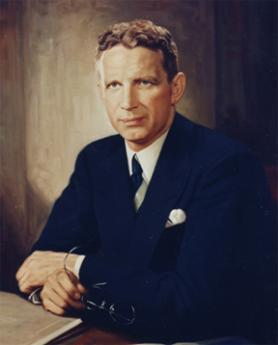2 Volumes
Tourist Trips: Philadelphia and the Quaker Colonies
The states of Pennsylvania, Delaware, and New Jersey all belonged to William Penn the Quaker in one way or another. New Jersey was first, Delaware the last. Penn was the largest private landholder in American history.
Regional Overview: The Sights of the City, Loosely Defined
Philadelphia,defined here as the Quaker region of three formerly Quaker states, contains an astonishing number of interesting places to visit. Three centuries of history leave their marks everywhere. Begin by understanding that William Penn was the largest private landholder in history, and he owned all of it.
Land Tour Around Delaware Bay
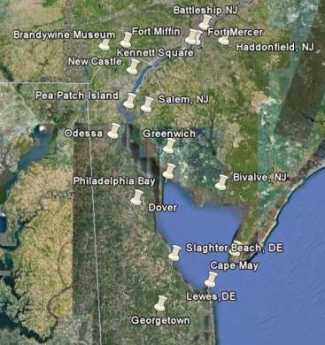 Start in Philadelphia, take two days to tour around Delaware Bay. Down the New Jersey side to Cape May, ferry over to Lewes, tour up to Dover and New Castle, visit Winterthur, Longwood Gardens, Brandywine Battlefield and art museum, then back to Philadelphia. Try it!
Start in Philadelphia, take two days to tour around Delaware Bay. Down the New Jersey side to Cape May, ferry over to Lewes, tour up to Dover and New Castle, visit Winterthur, Longwood Gardens, Brandywine Battlefield and art museum, then back to Philadelphia. Try it!

Benjamin Franklin, naturally, was the first to notice that the Delaware River wasn't a normal or at least ordinary river. In fact, coming downstream you might say the Delaware River ends at Trenton, emptying into what was once clearly a bay separating Pennsylvania from that barrier island we now call southern New Jersey. At Trenton, the bay filled in and attached the sandy island to the mountainous coast in a strip running north from Trenton to New Brunswick. South Jersey is a sandy peninsula if you wish, divided from a second more southerly sandy peninsula that we call the state of Delaware, or the Delmarva Peninsula.
From the viewpoint of migrating Europeans, the dominant issue was trees. The land north of Salem was an oak forest, very suitable for ship building. But bad for farming, because you first had to cut down those trees and pull up their stumps before you could plant anything. For at least the first year after settling, you had to subsist on what you could hunt or fish. If you couldn't farm, you might likely starve to death. Our ancestors, I'm sorry to say, hated trees and mostly continued to hate them until at least 1900. Flat marshy land around an inlet, estuary, or river delta was much to be preferred. The Dutch, who had mastered this salt marsh environment around the mouth of the Rhine, were enthusiastic early settlers of Delaware Bay, and the Swedes who were pretty good fishermen were also attracted. Both learned in time there was a big problem; swamps breed mosquitoes, and mosquitoes carry malaria, yellow fever, dengue, etc. But curiously that led to wholesale abandonment of some pretty cute Colonial villages in original condition, which are today still worth an informed visit before termites and Wal-Mart get to them.
Day One: Camden to Cape May
 Settlements for three centuries have clustered along both sides of the Delaware Bay, like beads on two parallel strings. 
|
| Dr. Fisher |
The Capital of southern New Jersey alternated between Salem and Burlington, and the King's Highway ran between them atop a clay ridge all of fifty feet above sea level. Colonial villages are strung along Kings Highway about ten miles apart, just like villages in the Midwest and for the same reason. That's about the distance a farmer's wagon could travel to market and return in one day. Travel by boat modified that somewhat. One unexpected feature: the marl clay ridge was eventually found to contain the first known dinosaur bones, still proudly on display at the Academy of Natural Sciences. We'll defer until Day Two describing the interesting origins of the coastal route on the Delaware side of the bay below the big river bend at Salem. In New Jersey the counterpart is the Del-Sea Drive, now rapidly fragmenting in response to school crossings and traffic. Although almost everything of interest is along these three roads, for this tour we propose taking President Eisenhower's interstate highway system, with side-trips as needed.
The retreating British Army ferried out of Philadelphia in 1778, went from Camden to Haddonfield and turned north on King's Highway. For this tour, we turn south from Haddonfield, pausing for a glance back at Camden. Poor Camden scarcely exists anymore, but the battleship New Jersey is parked there, the waterfront view is awesome, and Walt Whitman's home is open to tourists. Once the home of shipbuilding, Campbell's Soup, RCA/Victor, and the terminus of railroads at the ferries to Philadelphia, the town was first threatened by isolation by the Pennsylvania Railroad going down the other side of the river in 1839, but ultimately made economically redundant by the construction of the Ben Franklin Bridge in 1926. An interesting sociological study called Camden After the Fall relates how one futile effort after another to restore Camden after 1950 led only to riots and chaos; it's difficult to suggest anything which has not already been tried and abandoned. The present unstated but relentless approach is to tear the obsolete buildings down as they deteriorate, leaving vacant land which will eventually coalesce and become attractive to developers. Toll houses could be found along the turnpike to Haddonfield until 1960, but the automobile made Camden obsolete. What's left begins with the suburbs five miles away.
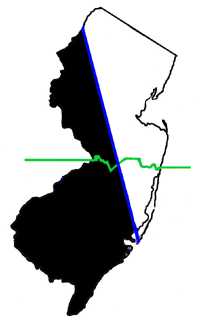
|
| New Jersey Line |
Haddonfield was a plain little Quaker town with undiscovered dinosaurs buried underneath it until the Revolution when the fugitive New Jersey legislature met in the Indian King Tavern and created the State of New Jersey. Because the Pennsylvania/New Jersey fortifications of the Delaware River at Fort Mifflin/Red Bank blocked the British fleet, Hessians were sent to attack New Jersey's Fort Mercer from the rear, staying overnight in Haddonfield. One young Quaker, a famous runner, ran ten miles to alert the defenders of Fort Mercer, who then defeated the Hessian attackers the next day by pretending not to notice the Hessians until they suddenly turned around and ambushed them. Later on, after the British occupied Philadelphia, General "Mad Anthony" Wayne rounded up cattle in Salem County and drove them to Trenton, then over to Valley Forge to relieve Washington's starving troops. The British responded to this with a famous massacre in Salem County by cavalry under Col. John Simcoe. So off we go to National Park, originally called Red Bank because of the reddish color of the clay riverbank at that point on the river, to see Fort Mercer. From here we travel to Salem, seeing its sadly dilapidated Colonial buildings, and the oak tree which was already famous among the Indians for its huge size in 1683. Along King's Highway, we pass through Mickleton, Mullica Hill, and Woodstown, three cute little Quaker villages waiting to be overwhelmed as suburbs.
From here we go to Greenwich, named for Connecticut settlers, where Paul Revere stirred up a tea-burning party in sympathy with the Boston event, on his way to promote even greater agitation in Philadelphia. Greenwich is sometimes referred to as a second Williamsburg, but what's here is original, not reconstructed. In passing, this tour takes us past Hancock's Bridge where Simcoe massacred those farmers who sold cattle to Anthony Wayne. That's biased local history speaking; in fact, Tory-Rebel reprisals were very bitter on both sides. Until ten years ago, this blood-stained site stood alone in the lonely moors, but unfortunately, it's pretty much built up and harder to find in the new suburbs than it was in the reeds.
From Greenwich we go on to Cape May, with a brief detour to Bivalve. The point about this stop is the perfectly gigantic pile of oyster shells left over from the days as a center of oyster harvesting. Notice the roads; they're paved with oyster shells. Oysters eat algae, sewage fertilizes algae. Overfishing the oysters caused rotting algae and bacterial overgrowth in the river. The result was depletion of the dissolved oxygen, dead areas for fish, murky water instead of a clear stream. It's an opportunity for oyster farming, but the vast piles of shells at Bivalve are a warning of how far we have to go before we restore the river.
Cape May was the first Atlantic Ocean beach resort, reached from Philadelphia and Tidewater Virginia by boat long before roads were usable. We are told Cape May was originally a separate barrier island, joined to the rest of South Jersey only later. It was once a whaling port, and the Quakers of the region were more related to Nantucket than to Philadelphia. Whale-watching is popular here, but dolphin sightings are more reliably frequent. As you would expect, this cute little place has many fine restaurants and hotels. The hotels are so authentic that strangers share common bathrooms the way they always used to do, so bed and breakfast places can be preferable for snootier tourists. Those whose great-grandparents once stayed in places like the Chalfonte, however, find it important to rough it in traditional summer places. The ocean currents "tumble" the small stones in the beach so beach-walkers can amuse themselves looking for "Cape May Diamonds". Unfortunately, even the locals often have never heard of them, so you are probably on your own. From here, we take the forty-minute ferry ride to Lewes, Delaware.
Cape Henlopen, on the Delaware side of the entrance to the bay, is south but appreciably to the east of Cape May. That means that a line directly west from Cape May points well inside the mouth of the bay, to Slaughter Beach, or Mispillion Point on the Delaware side. The ocean salt water turns to fresh river water at about this level, making for remarkably good fishing at certain times of the year. Furthermore, horseshoe crabs come ashore here on both sides of the bay to lay eggs. Birds who took off from South America months earlier swoop out of the skies to eat the crab eggs on the appointed day. Hawks pause in the woods to fly together in flocks over the bay, based on their own signals. Mispillion Lighthouse is the greatest place on the Atlantic flyway for bird-watching, crab-watching, fishing and nature loving. But you have to know when to go there and remember the best local hotels do get filled up at those times.
REFERENCES
| Paul Revere & The World He Lived In | Amazon |
| Camden After the Fall: Decline and Renewal in a Post-Industrial City: Howard Gillette Jr.: ISBN-13: 978-0812219685 | Amazon |
Day Two: Rehoboth to Kennett Square
 So, if you want a glimpse of Delaware as it once was before the migrations, get in your car quick and take the tour.  |
Once you step off the Cape May-Lewes Ferry in Delaware, you can still find an occasional old soul who remembers when "the road" was built. The road they mean is the highway that finally connected Southern Delaware to Wilmington. Before 1925, travel between the two ends of that little state was by railroad, or by boat, mostly the Wilson Line. It is natural to suspect the railroad and the boat line might have lobbied against road building, and they certainly had an economic incentive. But there were social factors, too. Although it is a tiny state, Delaware has long been a collection of independent tribes. New Castle County is of course very Ivy League; the Wilmington area claims to have more PhDs than any other American county. Southern Delaware was a slave region, forcing the state to be in favor of the Union, but also in favor of slavery -- a border state. Furthermore, pirate lairs seem to have created a mixed race along the shore calling themselves "Moors"; intermarriage with Indians and/or Portuguese pirates has been speculated as a source of swarthiness. Along the Atlantic coast, it is claimed that pure Elizabethan English is still spoken. Furthermore, the maritime orientation of Lewes created more social affinity to Cape May and Philadelphia than to New Castle and Wilmington. Eastern shore Maryland was even closer. Finally, in 1923, Coleman DuPont gave up on persuasion, built a 98-mile highway from one end of his state to the other at a cost of $50,000 a mile, and just gave it to the state. The legislature at first wouldn't take it, thinking it was clever to let the rich DuPont fellow pay for its upkeep. However, the sight of a DuPont cavalry of highway patrolmen raised even more discomfort, so the legislature reconsidered, accepted the gift.
The legislature was right, in a perverse sort of way, because Wilmington folk promptly poured down to the beaches in the summer, to the duck blinds in the fall, retirees built houses where living was cheaper, southern Delaware children wanted to go North to college, the blonde girls of Swedish or Dutch ancestry went north to become someone's secretary, maybe marry him. The railroad and the boat line went bankrupt, segregation was declared unconstitutional, everybody got television and a pickup. Eventually, someone in the Chamber of Commerce got the idea of jiggering tax laws to encourage out-of-state retail, then banking, then credit cards. The transformation of Delaware into a tax haven brought welcome socio-economic competition to the monolithic Dupont Company, abating the benign hereditary aristocracy that had grown out of it. So, if you want a glimpse of Delaware as it once was before the migrations, get in your car quickly and take the tour. There have even been rumors that the Cape May ferry may close.
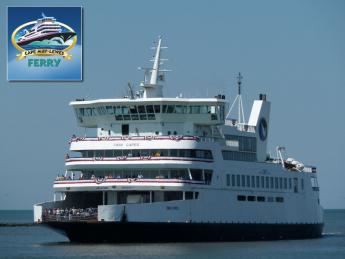
|
| Lewes Ferry |
Lewes was once a little seaport, but mostly a home for river pilots. There is a canal across the base of Cape Henlopen peninsula, and the pilots' imposing houses line the canal. But vacationers and sportsmen are now building waterfront houses as fast as they can, so old Lewes is getting lost. Rehoboth down the road has ocean beaches and higher land, so it offers suburban living at the beach, year-round. We don't plan to visit nearby Georgetown on this tour, but it's only ten miles away and presents an interesting legal anachronism in the Court of Chancery, for lawyers and historians to admire.
To take the Delaware turnpike from Lewes to Wilmington is quicker, but history is to be found by winding along Route 9, through the moors, marshes, and farmland. The Wesley Chapel is a place where John Wesley really preached in his tour to extend Anglicanism, and unintentionally to found the Methodist Church. The Bombay wildlife sanctuary is an interesting place to see migrating birds, although the birds may enjoy mosquitoes more than you do. You will be astonished to learn there were once so many peach trees in this area that Delaware was nicknamed the Peach State. Just outside Dover is the Air Force base, which somehow specializes in mortuary affairs during shooting wars. But there are real warplanes there, too, as became very evident during the Cuban Missle crisis. The sky seemed filled with huge eight-engine bombers, just circling around, waiting for orders to go lay an egg or two. The Air Force Base is a peculiarly international community to be living in rural Delaware; a pilot making regular trips to Guam had no difficulty keeping monthly appointments with me for a while.
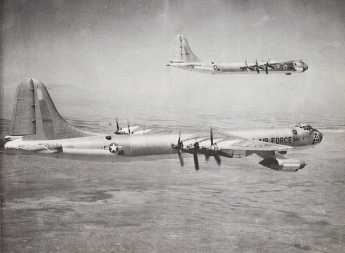
|
| bomber |
If you watch for directions just south of the airbase, you can travel out in the farm country to the Delaware estate of John Dickinson. As a young man, Dickinson fought a bitter battle in the Pennsylvania Assembly against Benjamin Franklin's efforts to remove the Penn Family from control, and although he lost the King's decision, winning that decision caused Franklin to be essentially banished to England for years as a consequence. Much later, Dickinson swung the critical vote toward Independence by abstaining from voting on the point at the Continental Congress, but wouldn't sign the Declaration. Nevertheless, he volunteered to fight as a private when the British invaded. He started and ended life as a Quaker but was the richest man in the state in between times, was Governor of Pennsylvania and Delaware at the same time, freed his slaves but kept secret the discovery that it actually made his farms more profitable to hire farm workers. A truly remarkable person, living in what you will see were rather plain circumstances.
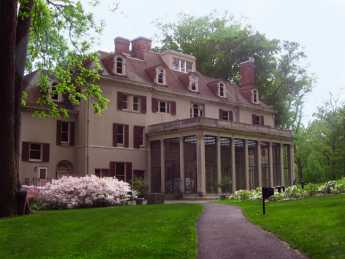
|
| Winterthur |
Dover itself is worth a quick trip to the colonial heart of it unless you become engulfed in traffic to the race track. Then a quick visit to the Blackbird pirate sanctuary of the pirate Blackbeard, and on to Odessa and New Castle, which are both real jewels. You can scarcely miss Odessa, which is at the narrowest neck in the Delmarva Peninsula, an isthmus that necessarily must eventually choke up with highways; Odessa has a Christmas festival worth a trip just for it. New Castle is far more uniform in appearance because it burned shortly after the Revolution and was rebuilt in pure Federalist style, then froze in time when the capital moved to Dover.
Then, skirt around Wilmington to the chateau country and try to decide between visiting Winterthur, Longwood Gardens, the Brandywine (Wyeth) Museum, the Brandywine Battlefield, and the mushroom area around Kennett Square. Generally speaking, Winterthur is at the top of the list.
If you left enough time, you may want to circle back through the Main Line suburbs, or through Swarthmore, to Chestnut Hill and Germantown, then down to center city Philadelphia. However, you may be tired, and just want to buzz back from Kennett Square by way of I-95.
Delaware Bay Before the White Man Came
Captain John Smith of Virginia, sometime friend of Pocahontas, wrote a letter to Captain Henry Hudson that he understood there was a big gap in the continent to the North of the Virginia Capes, and maybe this was the Northwest Passage to China. Hudson set out to look for it.

|
| Hudson |
Smith's misjudgment now seems like a credible story if you take the ferry from Lewes, Delaware to Cape May, New Jersey. You are out of sight of land for half an hour on that trip, and it's a hundred miles of blue salt water to Philadelphia if you decided to go in that direction. In fact, the bay widens out to double the width or more, just inside the capes, and you can see how an explorer in a little sailboat might believe there was clear sailing to the Indies if you went that way. But as a matter of fact, Hudson encountered so much "shoal" that he ran aground repeatedly trying to sail into the bay, and soon gave up. He encountered a swamp, not an ocean passage. The Hudson River, and later Hudson's Bay, seemed like better bets.
What Hudson had encountered was one of the largest gaps in the chain of Atlantic barrier islands, formed by the crumbling of the Allegheny Mountains into the sea, and then washed up as beach islands by the ocean currents. At various points, the low flat sandy islands became re-attached to the mainland as the intervening bay silted up, and that's why the islands of New Jersey and Delaware seem like part of the mainland. And that's what would have happened to the whole Delaware Bay if it hadn't been ditched and dredged, and wave action diverted with jetties. The swamp was a great place to breed insects, so fish were abundant, and that brought birds in vast numbers. Two stories illustrate.
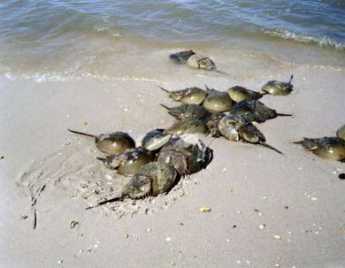
|
| Horseshoe Crabs |
Once a year, a zillion ugly Horseshoe Crabs crawl out of the sea onto the Lewes beaches, and lay a million zillion eggs in the sand. Almost to the moment, a swarm of South American birds swoops out of the skies to eat the eggs. Those birds started flying months earlier from thousands of miles away, but their timing with regard to Delaware crab eggs is perfect, so this evolutionary semi-miracle must have been going on for many centuries.

|
| Cape May |
Now, coming from the other direction, every hour each fall it is possible to see a hawk or two flies south to Cape May, then sort of disappearing in the woods. And then, at some unknown signal, tens of thousands of hawks rise from the bushes and travel together on the thirty-mile passage over the bay and then go on South. Cape May has lots of migratory birds and bird watchers, and it also has Cape May "diamonds", which are funny little stones washed up at the tip of Cape May Point.
In the spring, vast schools of successive species of fish migrate up the Delaware Bay to spawn in the reeds along the shoreline, but as each school encounters the point where the salt water turns fresh, they stop dead. They mill around at this point for several weeks adjusting to the change of water and then go on about their business. While they are there, it is possible for amateurs to catch amazing amounts of fish, if you know the best time, and if you know where the salinity changes. Since heavy or light rainfall can shift the salinity barrier fifty miles, you have to own your own boat if you want to enjoy this phenomenon, since the rental boats are all spoken for months in advance. Fishermen don't like to tell you about such things; patients of mine who literally owed me their lives have refused to say where I might find the fish this year.
Over on the New Jersey side of the bay, oysters like to grow, although something has just about wiped them out in recent decades. There is a town called Bivalve, which is worth a visit just to see the towering piles of oyster shells left over from last century. For miles around, the roads are actually paved with ground-up oyster shells. Up north around Salem, the shad used to run by the millions until the warm water emerging from the Salem (nuclear) power plant attracted them into the intake pipes and action was taken to abate the nuisance. The Salem Country Cub is one of the few places where planked shad can be obtained in season. The system is to split the fish open and nail it to a board, which is then placed in the big open fireplace to cook, and sizzle, and smell just wonderful good. On the other hand, if you want to buy shad in season (March-May) and cook it at home, the place to get it is in Bridgeton.
At the far northern end, at Trenton, the real Delaware River flows into the bay. The area has long since been dredged, but at one time the "falls" at Trenton were notable. Even today, if you travel upriver almost to Lambertville, you will see the river drop over several small ledges. Actually, rapids would probably be a better descriptive term, since Delaware picks up quite a strong current coming down from the Lehigh Valley. In seasons of heavy rainfall, the falls can be completely "drowned".
And down at Philadelphia where we live, the Schuylkill joined Delaware, forming the largest swamp of all at the river junction, a place once famous for its enormous swarms of swans. The Dutch discovered a high point of land at what is now called Gray's Ferry and made it into a trading place for beaver skins from the local Indians. There seems no reason to doubt the report that they took away thirty thousand beaver skins a year from this trading post, now the University of Pennsylvania.
An English sailing vessel was once blown to the East side of Delaware at what would now be Walnut Street in Philadelphia, and it was recorded in the ship's log that it was scraped by overhanging tree limbs. The high ground at that point seemed like a favorable place to situate a city because the water was deep enough for ocean vessels. They had stumbled on one of the relatively few places in the whole bay that was both defensible and navigable, where the game was abundant, and fishing was good. The rest is history.
Tony Junker: Tunnell's Boys

|
| Henry Hudson |
When you take the ferry across the mouth of Delaware Bay from Lewes to Cape May, you are out of sight of land for half an hour. But the Army Corps of Engineers have thoroughly dredged it out. By contrast, when Henry Hudson first discovered the river while searching for a Northwest passage to the Indies, it was so full of snags and shoals that he just gave up and sailed on to what is now New York harbor. So, for centuries the river pilots were an essential part of ocean commerce to Philadelphia. As you might well imagine, the earliest pilots were members of local Indian tribes. Eventually, a proud colony of professional pilots grew up at Lewes, Delaware. Since radio communication is a comparatively recent development in this ancient trade, they had to devise ways for an incoming ship to select a pilot, and establish rules to be enforced by the Port Wardens about how to go about it.
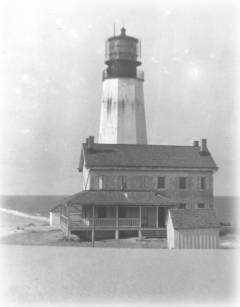
|
In the mid-Eighteenth Century, the system was to hang a black ball from the Cape Henlopen lighthouse whenever a ship was sighted. Little companies of ten or fifteen pilots would then jump into very fast schooners designed for the purpose, and race to be first out to the ladder hanging from the incoming ship's side. The rule was, the first to arrive and present his certificate got the job. Tony Junker, an actively practicing Philadelphia architect has immersed himself in tales and adventures among the pilots, and Tunnell's Boys is an exciting new novel about this dangerous, wet and uncomfortable, profession.
The Philadelphia Bay (1)
It's about sixty miles from Salem, New Jersey where the river takes an abrupt turn to the right, to Trenton, where the river takes an equally abrupt turn to the left. This is the area that could be called the Philadelphia Bay, a protected extension of Delaware Bay. Benjamin Franklin, who sailed down this bay on his many trips to Europe, noticed that it was not exactly a river, because the salt water seemed to invade it, whereas most big rivers have fresh water pushing out to sea. The true Delaware River comes down from the north and empties into Philadelphia Bay at Trenton. We now know that barrier islands begin out at sea every three hundred years or so, gradually move toward the shoreline, and pack themselves against the mainland about three hundred years later. Depending on circumstances, there are usually several sand reefs in various stages of development. Southern New Jersey is made up of a number of barrier islands packed together as they moved toward the mainland of Pennsylvania. The barrier islands actually have packed solid against the Pennsylvania coast, from Trenton to New Brunswick, closing off the ancient northern inlet to the bay. Barnegat Bay is a more recent variant of the same process, running parallel to the more ancient Philadelphia Bay. Since its northern inlet is almost closed at Barnegat Inlet, this seems to be a regular phenomenon of Atlantic barrier island development. Lower Delaware Bay, from Salem to Cape May, appears to have a different history, probably a volcanic split.
|
||
| Joshua Fisher's 1778 Map of Delaware Bay |
In the days of sail, Philadelphia Bay was the main artery of internal commerce. When the Delaware-Chesapeake canal was dug in 1829, it extended the inland waterway from Trenton to Norfolk VA. The earliest commerce took advantage of the tide and the bends in the "river" which was actually just the remnant of ocean between mainland Pennsylvania and the former barrier island of New Jersey. It had tides, but not much in the way of waves. Flatboats filled with Garden State produce would be carried up and across the river by the incoming tide, and down and across the river by the outgoing tide. When ships, particularly steamships, came along, this was the way to carry goods of all sorts up and down the Bay. At Odessa, it's only five miles between the Chesapeake and Delaware Bays, so even prior to the old Delaware-Chesapeake Canal sailing commerce was natural from Trenton to Norfolk, Virginia, and all points in between. The next step was building canals, up to the Raritan to New York Bay, and even up the "Main Line" west to Pittsburgh and beyond. The war of 1812 blocked off ocean shipping, and then another canal carried anthracite to Philadelphia, emptying at Bristol, briefly enriching Bristol, but then leaving it reduced to its present vestigial state when the tracks of the Pennsylvania Railroad cut it off. After canals came railroad tracks, usually following the path of the canals, making smoke and noise, constructing a dangerous, impenetrable barrier between the land and the water beside it. Superhighways do the same thing, replacing soot with gasoline fumes. There's a river out there somewhere, but you can't get to it. It now takes a twenty story high rise to give you a river view; even that is best seen on Sunday when lessened traffic reduces gasoline haze.
It's really hard to imagine that main attractions to living on the river once included not merely the view and the transportation, but also wonderful fishing and hunting among the bullrushes. Down around the Delaware Chesapeake Canal, Blackbeard the Pirate used to hide his ship and merry men in the shallow marshes among the mud islands. There's a reminder of it as you speed along the elevated multi-lane highway, or maybe it's just another reminder of political correctness. If you know the way well enough to take your eye away from the traffic pattern, off to the right is a directional sign pointing to the little cove where pirates used to convene. It says, "Blackbird".
Jersey
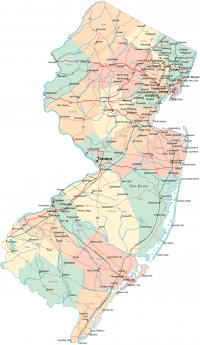
|
| Map of New Jersey |
Once you notice the oddity of salt water in the lower reaches of the Delaware and Hudson rivers, it gets easier to understand the current theory that southern New Jersey was once an island. Like Long Island, it was separated from the mainland by a sound, but in the Jersey case the sound silted up from Trenton to New Brunswick, creating a new peninsula of "West" Jersey by uniting the island with the mainland. The colony was named after the island of Jersey off the coast of England, a gesture for Sir George Carteret, who was given the American area out of gratitude for once sheltering the exiled royal brothers Charles II and James from Cromwell, in that other Jersey. Cape May was probably a second distinct island later joined to the larger one by the transformation of the silted ocean into the bogs of the Maurice River. Cape May started as a whaling community, populated by Quakers from New York and New England, who always maintained a social distance from the Philadelphia Yearly Meeting. The long Atlantic beaches of New Jersey now repeat the main geological process, with successive generations of barrier islands first heaved up by the ocean and then packed against the mainland, filling up the brackish bay. The cycle of forming and packing successive barrier islands takes about three hundred years before a new one starts. In a larger sense, the process consists of the former mountains of Pennsylvania crumbling into the ocean and then responding to wave action.
It's no mystery, therefore, why southern New Jersey is flat, broken up by turgid meandering streams which casually empty in either direction. The head of Timber Creek, which flows into Delaware, is only eight miles from the head of the Mullica River, flowing toward the ocean. During the Revolutionary War, the British found it too dangerous to sail up these winding creeks, since at any moment they might make a sharp turn and be facing a battery of cannon on the shore. An arrangement quickly grew up that buccaneers would build ships in the center of heavy oak forests and sail them out to Barnegat Bay, thence out one of the inlets of the barrier islands into the blue water. The financiers of Philadelphia, many of them with names now in the Social Register, would come from the rear, sailing up the Delaware River creeks, and walking the last mile or two to privateer headquarters on the Atlantic-flowing creeks. Auctions were conducted, in which the ships were examined, the captain interviewed, and the crew observed in target practice. If you bought a small share you would be rich when the ship returned; and if it never returned, well, you had to invest in a different one. New Jersey is indignant of the opinion that these privateers were mainly responsible for winning the Revolution, but given little credit for it. Many more British sailors were lost to the privateers than soldiers were lost to Washington's troops and the economic loss to Great Britain of the ships and cargoes eventually became serious. Since much of the profit from privateering was recycled into the American war effort by Robert Morris, the British found themselves facing an enemy much more formidable than just the ragged frozen troops at Valley Forge on the Schuylkill. Meanwhile, William Bingham was conducting a similar privateering operation in partnership with Morris but based on the island of Martinique, but that's another story.
In later centuries, the traditions and geography of the Jersey Pine Barrens suited themselves to smuggling and bootlegging during the era of alcohol Prohibition, and even after Repeal, high taxes on liquor kept bootlegging profitable. As late as the 1950s, there were divisions of FBI men prowling the woods of South Jersey, on the lookout for trucks carrying bags of cane sugar, or coils of copper tubing. After housing developments started to invade the forests, the hardball politics of South Jersey reflected a Mafia culture thought more characteristic of South Philadelphia. Near Vineland and Atlantic City, it isn't just a culture, it has the accent, because it also has some of the ancestry.
REFERENCES
| New Jersey, A Historical Account of Place names in the United States: Richard P. McCormick: ISBN-13: 978-0813506623 | Amazon |
Remember This Date: May 18
 Delaware Bay is teeming with successive migrations of seafood. May 18 is a pivotal day, give or take a few days. 
|
| Dr. Fisher |
A group of Texas and California friends were recently led on a two-day tour around lower Delaware Bay, down the New Jersey side to Cape May, ferry ride to Lewes on the Delaware side of the bay, and then home. The timing of this adventure had more to do with azalea and dogwood season than wildlife, but the date chosen was very fortunate: May 18.
It just happens that May 18 is the last day of the shad season. That's dictated by Mother Nature of course, but it also has a lot to do with Dill's Seafood in Bridgeton. For almost a century, this wholesale seafood store has dominated the shad business in the region. At one time, they shipped six thousand pounds of shad daily in season, although in recent years the business has dropped to five hundred pounds a day. Even today that's a lot of fish, supplying boned shad and roe to every restaurant with shad pretensions for a hundred miles around. They do have a restaurant attached, with pitchers of cold beer on the table, and enthusiasts in great numbers.
The source of this monopoly is a very large family of Italian sisters, who have developed the skill of de-boning shad in about thirty seconds. Shad are just about inedible with the bones intact, and most amateurs make a mess of the matter if they try to de-bone the fish themselves. As the supply has dwindled, few people develop the skill needed to compete with these ladies, and the seafood industry has just surrendered the field to them. Although shad have been successfully transplanted to Oregon, the fish is native to the Atlantic Coast, and my Western visitors had never heard of them. What's really special is to fry or bake the half-pound roe sacs, with bacon of course. Shad roe with bacon and beer, now there's really something to talk about. Shad start to "come in" in January, and the last day of the season, the very last day, is May 18.
We then took a forty-minute ferry ride from Cape May to Lewes Delaware, thirty minutes out of sight of land. The reports in the taprooms of Lewes were that no one had yet seen any horseshoe crabs, it was apparently too early for them. But we had passed the point of no return, so we went on to Slaughter Beach. The origin of the name of this beach is obscure as far as local residents are concerned, although it is fun to remember that these were pirate coves in the Sixteenth Century. Captain Kidd, no less. It is also the place where salt water generally turns fresh, depending on the season and the rainfall, a matter of great importance to migrating fish who tend to hang up here in great abundance.
Well, May 19 turned out to be the first day of the season for horseshoe crabs, so our luck was doubly fulfilled. These terribly ugly brown rascals are about the size of a dinner plate, with a long pointed tail, and they come tumbling in on the surf upside down and sideways. Thousands of them are coming, but on the first day, there was a pair of them every six feet or so. This is the famous limulus, which is really more closely related to scorpions than crabs. The tail doesn't seem to have poison, but it is razor-sharp as my younger son discovered when he picked one up by the tail to throw him (?her?) back into the ocean. He got a deep bloody gash for his reward.
The Limulus isn't edible, but it has its uses. It has four eyes, each attached to a single large nerve fiber, making it very useful for ophthalmology and neurology experiments. Its blood is blue since it uses copper instead of iron in its hemoglobin. That hasn't been put to any use, but the blood has a peculiar ability to clot when it comes in contact with bacterial toxins and has proved very useful for identifying toxic bacteria.
As far as amateurs are concerned, the horseshoe crabs attract a mob of seagulls, but we are assured that these are very special birds who take off from South America months earlier. They are said to arrive almost precisely when the crabs do and love to eat the eggs. One female crab produces twenty to fifty thousand eggs. As you approach the line of feasting birds, the near ones take off but the others remain, so the edge of the flock recedes as fast as you approach it. The vacated beach is peppered with the backs of the half-buried crabs, quite touchingly paired off, two by two. Inevitably, the question is raised how a male tells which one is a female. And inevitably the reply is, "That's his problem."
Where Do Shad Go, When They Aren't Around Here?
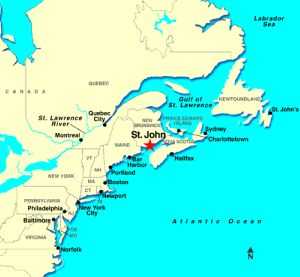
|
| BAY OF FUNDY |
Some day, we're going to clean up our rivers, and then maybe the shad will come back. Since every female shad produces a couple hundred thousand eggs a season, when the shad come back, there could be a lot of them. We now know some things George Washington didn't know about shad. For example, they all go to the Bay of Fundy, once a year. All of them, whether they spawn in North Carolina, the Delaware, or the Connecticut River.
By tagging them, it was learned that shad swim at a depth of several hundred feet, apparently seeking a certain amount of darkness, which is in turn related to the growth of algae and plankton, their favorite food. So, when the surviving shad go back down a spawning river to the ocean, they head North in a huge counter-clockwise ocean rotation, adjusting their depth to the degree of darkness. Just about the time summering Philadelphians start packing for Bar Harbor, the shad also reach the Bay of Fundy, which is muddy and dark. Fundy is famous for its unusually high tides, so the turbulent water achieves the shad's desired degree of murkiness at about thirty feet instead of the normally deeper waters of the cyclic migration in the open ocean. People who know about these things say that just about every shad on the East Coast passes through the Bay of Fundy in late spring. In the fall, the fish turn around and start to go South again, maybe following the sun, maybe seeking a desired temperature, or both. Somehow or other, this pattern of migration helps them escape predator sharks and seals, as judged by that wholesome entertainment, the examination of stomach contents. Look out for sharks and seals in the open ocean, but striped bass are the big enemies of fingerlings in the spawning rivers. The Hudson River curiously has lots of striped bass lurking among the abandoned piers, and so does the Chesapeake. The Delaware also has a few stripers around the mouth of the Rancocas Creek; go ahead and fish 'em out.
All of this brings us to a suggestion for our tourist bureau. Shad don't eat much when they are on a spawning run, but they will strike at a lure. That is, you don't use worms, you do fly-casting. If we ever got anything approaching the old shad runs in the Spring, you could expect thousands and thousands of eager fly-casters to flock to the Delaware, filling up our marinas, hotels, restaurants, and cabarets. You wouldn't need to advertise a river teeming with eight-pound action-eager fish; the news would spread like magic. The best proof of this claim can be found on the only river on the East Coast which continues to have a classic shad run. The existence of this river was told to me as a sworn secret, but the invitation to try it was given with the assurance that "every single cast results in a strike".
And here's the zinger. Except for that one secret stream, the Delaware is the only major river on the East Coast that doesn't have a dam between the ocean and the spawning grounds. Once these fish have picked a river, they keep coming back to it, forsaking all others. The situation positively cries out for Federal assistance, and the lure-casting fishermen of America demand no less. Presidential elections have been won and lost on less important issues than this one. But just one dedicated congressman could do it, particularly if he sits on the Committee on Fisheries. Bring back our shad and get rewarded with lifetime incumbency that even Gerrymandering can't dislodge.
Founding Fish
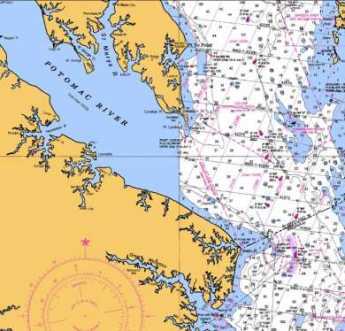
|
| Potomac |
In 2002, John McPhee brought out a perfectly splendid book about fish and fishing history in this region, with particular emphasis on shad. He makes the whole topic remarkably interesting, but you have to be a little wistful about the way he demolished a splendid story of fish in Philadelphia during the Revolutionary War. The book is called The Founding Fish.
As everyone knows, George Washington and the Continental Army were starving and freezing at Valley Forge, a few miles up the Schuylkill, while Major Andre and the other British officers were cavorting downtown with the Tory ladies, grr. The story has long been told that things got to a desperate state at Valley Forge when, lo, the annual shad run was several weeks early and mountains of fish came roaring up the river to the excited shouts of the starving patriots and rescued the raggedy starving Continental Army. It would make a wonderful scene in a movie.
McPhee tells us that George Washington was in fact a shady merchant, having caught and pickled many barrels of shad coming up the Potomac River. The annual shad excitement was no news to him, and it seems quite possible he selected the campsite at Valley Forge with this spring event in mind. Shad was no news to the British, either; there are records of their trying to block off the Schuylkill with nets to prevent the fish from getting upriver to Valley Forge.
Unfortunately, a careful search of letters and records fails to record any shad run earlier than April that year. The rescue of song and story does not appear in contemporary documents. What's more, some unnecessarily diligent scholars have sifted through the garbage heaps of the encampment area, and have only found pig and sheep bones, no shad bones.
Those graduate students undoubtedly deserve to be awarded degrees for their work, especially the digging in garbage part. But nevertheless, it all does seem a pity to ruin a good story that way.
Georgetown Oyster Eat: Separate but Equal

|
| Oyster Knife |
It's a source of some regret never to have attended the Georgetown Oyster Eat. It occurs in the middle of February when the days are dark and short, and the weather is uncertain for driving.
Local citizens of Sussex County, Delaware, report no one alive remembers when or how the custom began. In the nature of such things, a certain amount of historical inaccuracy is thus to be expected. It certainly did start out as an all-male event, taking place in the firehouse. One inflexible requirement is that a participant must bring his own oyster knife, which is a very heavy chunk of iron with a short blade attached, sort of like a screwdriver. The ones I have seen are all one piece of iron, suggesting they have been hammered out in a blacksmith shop. The flattened-out blade serves as an eating utensil, as well as a wedge to pry open the oyster shell. The oysters are eaten raw and whole, often with some sort of condiment, like horseradish sauce. Some eaters favor a whole lot of ground pepper, and various other ancient remedies are said to make an appearance. The main beverage is beer, lots of beer.
Beyond that, not much is known or divulged to the public, although a party attended by nearly a thousand tipsy people can't keep very many secrets. Before the party, the windows of the firehouse are covered with brown wrapping paper, sealed with tape. Kegs of oysters and kegs of beer are rolled into the firehouse before other things get rolling, and a lot of loud noises and laughter emerge almost all night. The sponsors claim to bring a thousand bushels of oysters to each party, although it is hard to imagine very many people eating their quota of a bushel apiece. The per-person beer consumption is a statistic kept confidential. The ladies of the neighborhood report numerous husbands eventually returning home, with their glasses broken, and suspicious red bruises on their faces. Aside from that, nobody knows nothing'.
About ten or fifteen years ago, feminism reached the Delmarva Peninsula, and the ladies started their own brawl. Renting the Grange Hall and brown-papering the windows, they make a lot of noise come out all night. Because of some sort of oyster virus, oysters are not nearly so plentiful any more. There's a more elaborate accusation that excessive fertilizer on the farm fields runs off and stimulates a bloom of algae, which depletes the oxygen of the river and kills a lot more than oysters. Anyway, the oysters are in short supply. If the local firehouse custom dies out, it won't be from lack of enthusiasm, however.
Georgetown Returns Day
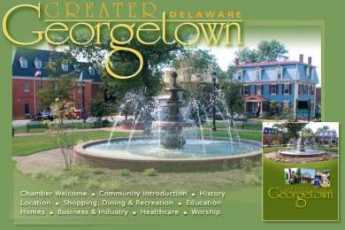
|
| Georgetown |
Early in November, two days after each election, Georgetown Delaware puts on a festival called Returns Day. About two hundred years ago, there was a law that all ballots had to be cast in person at the courthouse in the county seat (Lewes, at that time), and it took two days to count the votes. Everyone, candidates included, would hang around at the courthouse to learn who had won. After a few elections, except in wartime when the ceremony was temporarily skipped, the popular tradition has continued even though of course the election results are known much earlier. Although the function of revealing election results has yielded to the news media, the ceremony has assumed importance for its own sake. Unless it rains pretty hard, the parade lasts three hours, with ten or twelve marching bands, and local amateurs struggling with bagpipes. The candidates, winner, and loser, ride gamely around the square in horse-drawn carriages. You can imagine what would happen to the political future of any candidate who declined to participate in what is now a mandatory public entertainment.
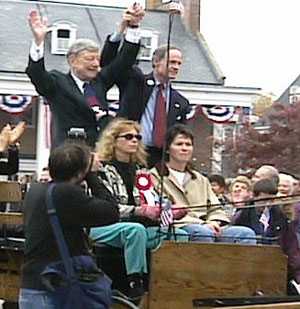
|
| U.S. Senator from Delaware |
Two features of this festival are especially notable. There is a hatchet-throwing contest, trying to get the flying hatchet to catch one corner in a post. It's not an easy thing to do. And then there is hatchet-burying, which is said to date back to the Nanticoke Indians. The traditional hatchet is brought from Lewes, as is the sand. This is all said to be the origin of the folk-saying about burying the hatchet, and it's really very heart-warming to believe the election is only an election, and the competition is over. It's probably not entirely true, of course, but it symbolizes what the public wants to believe is true. And what the public is telling politicians -- had soon better become true, again.
Delaware's Court of Chancery
 |
| Chancery |
Georgetown, Delaware is a pretty small town, but it's the county seat so it has a courthouse on the town square, with little roads running off in several directions. The courthouse is surprisingly large and imposing, even more, surprising when you wander through cornfields for miles before you suddenly come upon it. The county seat of most counties has a few stores and amenities, but on one occasion I hunted for a barbershop and couldn't find one in Georgetown. This little town square is just about the last place you would expect to run into Sidney Pottier and all the top executives of Walt Disney. But they were there, all right, because this was where the Delaware Court of Chancery meets; the high and mighty of Hollywood's most exalted firm were having a public squabble.
Only a few states still have a court of Chancery, but little Delaware still has a lot of features resembling the original thirteen colonies in colonial times. The state abolished the whipping post only a few decades ago, but they still have a chancellor. The Chancellor is the state's highest legal officer, and four other judges now need to share his workload, which was almost completely within his sole discretion seventy-five years ago. In fact, the Chancellor usually heard arguments in his own chambers, later writing out his decisions in longhand. The Court of Chancery does not use juries.
Going back to Roman times, the Chancellor was the highest office under the Emperor, and in England, the Lord Chancellor is still the head of the bar in a meaningful way. Sir Francis Bacon was the most distinguished British Chancellor and gave the present shape to a great deal of the present legal system. A court of Chancery is concerned with the legal concept of equity, which is a sense of fairness concerning undeniable problems which do not exactly fit any particular law. The Chancellor is the "Keeper of the King's conscience" concerning obvious wrongs that have no readily obvious remedy. You better be pretty careful who gets appointed to a position like that, with no rules to follow, no supervisor, no jury, dealing with mysterious issues that have no acknowledged solution.
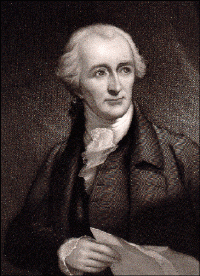 |
| George Read |
Delaware's Court of Chancery evolved in steps, with several changes of the state Constitution over a span of two hundred years. As you might guess, a few powerful chancellors shaped the evolution of the job. Going way back to 1792, Delaware changed its Supreme Court from the design of its Constitution, and George Read was the new Chief Justice. However, it was all a little embarrassing for William Killen, who had been the Chief Justice, getting a little old. Read refused to have Killen dumped, and in this he was joined by John Dickinson, who had been Killen's law clerk. So Killen was made Chancellor, and a court of Chancery was invented to keep him busy.
Under a new 1831 Constitution, the formation of corporations required individual enabling acts by the Legislature and limited their existence to twenty years. However, the 1897 Constitution relaxed those requirements and permitted entities to incorporate under a general corporation law and allowed them to be perpetual. By this time, other states were distributing equity cases to the county level, but Delaware was too small to justify more than a single state-wide Court. That court was attractive to corporations because it could become specialized in corporate matters, but retained a pleasing number of equity cases among common citizens, thus retaining a folksy point of view. In unique situations or those without a significant history of public debate, it was thought especially desirable to strive for unchallenged acceptance of the court's decision.
But other states thought they could see what Delaware was up to. In 1899 the American Law Review contained the view that states were having a race to the bottom, and Delaware was "a little community of truck farmers and clam-diggers . . . determined to get her little, tiny, sweet, round baby hand into the grab-bag of sweet things before it is too late." However, that may be, corporations stampeded to incorporate in the State of Delaware, and the equity of their affairs was decided by the Chancellor of that state. In one seventeen year period of time, the U.S. Supreme Court reversed the decision of the Chancellor only once.
 Chancery's jurisdiction was complementary to that of the courts of common law. It sought to do justice in cases for which there was no adequate remedy at common law.  |
| A. H. Manchester Modern Legal History of England and Wales, 1750-1950 (1980) |
Some legal scholar will have to tell us if it is so, but the direction and moral tone of America's largest industries has apparently been shaped by a small fraternity or perhaps priesthood of tightly related legal families, grimly devoted to their lonely task in rural isolation. The great mover and shaker of the Chancery was Josiah O. Wolcott (1921-1938), the son and father of a three-generation family domination of the court. Most of the other members of the court have very familiar Delaware names, although that is admittedly a common situation in Delaware, especially south of the canal. The peninsula has always been fairly isolated; there are people still alive who can remember when the first highway was built, opening up the region to outsiders. Read the following Chancelleries quotation for a sense of the underlying attitude:
"The majority thus have the power in their hands to impose their will upon the minority in a matter of very vital concern to them. That the source of this power is found in a statute, supplies no reason for clothing it with a superior sanctity, or vesting it with the attributes of tyranny. When the power is sought to be used, therefore, it is competent for anyone who conceives himself aggrieved thereby to invoke the processes of a court of equity for protection against its oppressive exercise. When examined by such a court, if it should appear that the power is used in such a way that it violates any of those fundamental principles which it is the special province of equity to assert and protect, its restraining processes will unhesitatingly issue."
That is a very reassuring viewpoint only when it issues from a person of totally unquestioned integrity, a member of a family that has lived and died in the service of the highest principles of equity and fairness. But to recent graduates of business administration courses in far-off urban centers of greed and striving, it surely sounds quaint and sappy. And many of that sort have found themselves pleading in Georgetown. Just let one of them a bribe, muscle, or sneak into the Chancellor's chair someday, and the country is in peril.
John Dickinson, Quaker Hamlet
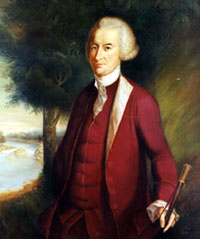
|
| John Dickinson |
John Dickinson (1732-1808) would probably be better known if his abilities were less complex and numerous. It would have been particularly helpful if he had consistently remained on only one side of the important issues of his day. Born in a Quaker family and buried in a Quaker graveyard, he was for years a notable Episcopalian and soldier. He outwitted John Penn, the Pennsylvania Proprietor who was trying to keep Pennsylvania from sending representatives to the Continental Congress, by having the Pennsylvania representatives hold a meeting in the same small room of Carpenters Hall at the same time as the Congress. But he ultimately refused to sign the Declaration of Independence. Although he was the main author of the Articles of Confederation, the Constitution which replaced it would not have been ratified without his idea of a bicameral Congress. Although he was Governor of Pennsylvania, he was also Governor of Delaware, has been the central figure in the separation of the two states. In fact, for fifteen years he was a member of the Legislature of both states. Dickinson seems in retrospect to have been on every side of every argument, but he was immensely respected in his time.
Two events seem to have been central in the organization of his life. The first was his education as a lawyer. At that time and for a century afterward, lawyers were trained by apprenticeship. Dickinson, however, studied in London at the Inns of Court for four years and was by far the most distinguished lawyer in North America for the rest of his life. Furthermore, he absorbed the principles of the Magna Carta and the approaches of Francis Bacon so thoroughly that he never quite got over his pride in his English heritage. Throughout his leadership of the colonial rebellion, he acted as a better Englishman than the English themselves. His demand was for American representation in the British Parliament, not independence from England. It would not be hard to imagine Dickinson standing before a firing squad, gritting the words of St. Paul, Civis Romani Sum.
His other pivotal experience was the Battle of Brandywine. Dickinson had been the organizer or chairman of the two main Pennsylvania military organizations, the Pennsylvania Committee of Safety and Defense, and the so-called Associators (today's 111th Infantry, the first battalion of troops in Philadelphia). Both of these particular names were a characteristic gesture to conciliating pacifist Quaker feelings. Nevertheless, when Dickinson refused to sign the Declaration, he did temporarily become so unpopular he resigned his military commands. A few months later, when General Howe landed at Elkton at the narrow neck of the Delmarva peninsula, Dickinson enlisted as a common soldier to defend the southern perimeter of the defense line Washington had hastily thrown up to defend Philadelphia. Shortly afterward, Dickinson's friend and neighbor Caesar Rodney made him a Brigadier General in charge of the garrison around Elizabeth New Jersey, but the Battle of Brandywine taught an important lesson. Little states like Delaware and Maryland could not possibly defend themselves witho
A Pennsylvania Farmer in Delaware
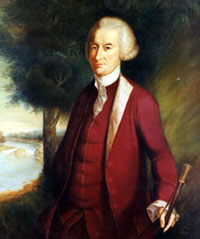
|
| John Dickinson |
It is difficult to have a coherent view of the mind of John Dickinson. Seriously offended by the Townshend Acts, he rightly perceived them to be the work of a few malignant personalities in British high places who would mostly soon be replaced. Later on, he refused to be troubled by the inconsequential Tea Act, which he appraised as a face-saving gesture of reconciliation, but more recent historical information demonstrates was more likely aimed at avoiding an unrelated vote of no-confidence in Parliament. Unfortunately, Dickinson was too remote from these events and additionally could not comprehend reckless hotheads among his own neighbors. Reckless hotheads in turn seldom comprehend the measured meekness of Quakers. In any event, although Dickinson played a major role in the Declaration of Independence, he refused to sign it when the time came, evidently sensing an opportunity to separate the three lower counties from Pennsylvania and its Proprietors. A few months later when the British actually invaded the new State of Delaware on the way to capturing Philadelphia by way of Chesapeake Bay, Dickinson enlisted as a common soldier and fought at the Battle of Brandywine. Obviously, he was seriously conflicted.
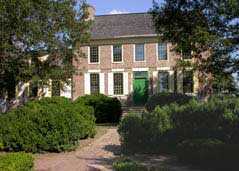
|
| John Dickinson's Farmhouse |
Dickinson had become internationally famous for twelve letters he had meant to publish anonymously. The Letters From a Pennsylvania Farmer were written about 1768 out of resistance to the Townshend Acts. Because the three counties which were to become the State of Delaware were then still part of Pennsylvania, many school children have become understandably confused about the actual location of the man who became governor of both states, simultaneously.
The causes of the separation of the two colonies are still a little vague. Delaware schoolchildren are taught the two states separated, but often report they didn't retain much information about why it happened. The Dutch and Swedes who originally settled southern Delaware were not sympathetic with Quaker rule, which could be seen as a reaction to their living here for generations as Dutchmen before William Penn arrived, but then saw the colony sold out from under them. As a further conjecture, there might have been friction with the Quakers over slavery, similar to the hostility of other Dutch settlers in northern New Jersey when William Penn purchased that area. This pro-slavery attitude resurfaced in both areas during the Civil War. One alternative theory which has considerable currency in Delaware is local dissension about Quaker pacifism during the Revolutionary War. On a recent visit to Dickinson's home outside Dover, a school teacher was overheard to instruct his flock that the Dutch Delawarians wanted to fight the British King, but the Quakers wouldn't give them guns. "We value peace above our own safety," was the unsatisfying response they received from the Pennsylvania Assembly. But that line of reasoning bumps up against Dickinson's role in local affairs, his ambiguity over the Declaration, and his vacillation in warfare. One would suppose the simultaneous Governor of both states would play a major role in the separation of the two.
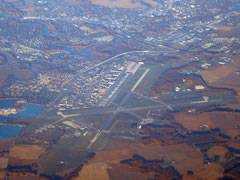
|
| over Air Force Base |
Dickinson's plantation, quite elaborately restored and displayed, is tucked behind the Dover Air Force Base. Perhaps all that aircraft noise will discourage sub-development in the area of Dickinson's plantation and the rural atmosphere may persist for years. At the time of the Cuban missile crisis, your correspondent happened to be driving past, observing the sky filled with bombers, just circling and circling until the diplomats settled matters. Since eight-engine bombers are seldom seen around Dover, it has always been my presumption that they came from elsewhere to be refueled at Dover; but that's just a presumption. One of the pilots later told me he was carrying nuclear "eggs" and was completely prepared to take a long trip to deliver them.
To get back to Dickinson's wavering about the Declaration, maybe there was a good reason to waver. Joseph J. Ellis (in His Excellency, George Washington) relates that after the devastating British defeat at the Battle of Saratoga, Lord North made an offer to settle the war on American terms. In a proposal patterned after the concepts of the separatists in Ireland, America could have its own parliament as long as it maintained trade relationships with England. As an opening offer, that comes pretty close to what the colonists had been demanding. Governor Morris was active in disdaining this offer, although it is unclear whether he was acting alone or as the agent of others. The offer came too late to be accepted, but it might have shortened the war by six years, and we might now have a picture of the Queen on our postage stamps.
REFERENCES
| His Excellency: George Washington: Joseph J. Ellis: ISBN-13: 978-1400032532 | Amazon |
| Letters From A Farmer In Pennsylvania To The Inhabitants Of The British Colonies (1903): John Dickinson: ISBN-13: 978-1163969533 | Amazon |
Delaware Declares Independence ... From Pennsylvania
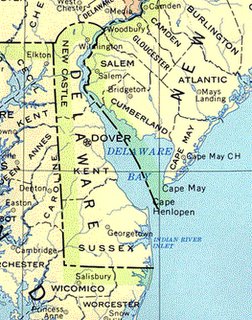
|
| Delaware Map |
To bewilder your friends from the State of Delaware, just ask them when and why Delaware broke off from Pennsylvania; chances are they haven't the foggiest answer. But they will recognize it is a legitimate question. Everyone does know that Delaware was once owned by William Penn and was part of Pennsylvania. It was generally referred to as the three Lower Counties. But what happened then doesn't seem to be taught very effectively in the Delaware schools, and not much is written about it.
Not much is written because not much happened. No revolutions, bombings, hangings or even acrimonious debate; just think how much Serbia, Russia, China, Sudan and a lot of other countries have to learn about self-determination, from Delaware.
The history of Delaware up to 1674 was of Dutch, Swedish and even some Finnish settlement and arguments; doesn't count. The Duke of York (later James II) owned it and seems brief to have toyed with combining it with New York; that's how Delaware happens once to have been called the South River, and the Hudson the North River. But William Penn acquired it in 1682, mostly with the motive of having unchallenged access to the ocean from Pennsylvania. Apparently, the people who lived away from the river felt more kinship with Maryland, and expressed unwillingness to be linked with some religious experiment in Philadelphia, especially if they had to travel there to settle their affairs. There is not much Catholicism in Delaware at present, but that seems to have been part of the uneasiness in 1701. So Penn granted them quasi-autonomy and their own separate assembly, which resulted in a peaceful enough arrangement until the American Revolution. Penn got all he wanted, which was to sell off the land and maintain a clear river passage, and by the time of the Revolution, his descendants had lost all control of things. The control of Pennsylvania over its three lower counties had never been terribly firm, and during the eight-year Revolutionary chaos, it sort of drifted away. When its votes were needed for the Declaration of Independence and later for the Constitution, it was expedient to recognize Delaware's claims.
That's perhaps all there is to this vague story of statehood building, except for one nagging doubt. Delaware was a plantation state and a slave state. It's sided with the North during the Civil War, but it remained a slave state. It voted against Lincoln's Emancipation overtures, and refused to ratify the Thirteenth, Fourteenth and Fifteenth Amendments until 1901. Until the Lewes-Cape May ferries got busy with Garden State Parkway traffic, lower Delaware's population was almost exclusively either African-American or many-generation English descendants. The hospitals had white-only and black-only restrooms until the Second World War. Nothing better illustrates that the Civil War was primarily fought to defend the Union, rather than to eliminate slavery, than the tangled local history of the border states, of which Delaware was definitely one.
And so, you have to wonder. Is it possible that the residents of the Lower Counties in 1776, especially in the southern portion where John Dickinson had a plantation, could recognize that the Quakers of Pennsylvania were relentlessly moving in a direction which surely would eventually conflict with the slave system? Maybe, looking ahead, the chaos of Revolutionary times provided a plausible moment to make a clean separation. These are awkward questions to ask, perhaps best passed by, in silence.
Pirate Lair

|
| Jolly Roger Flag |
Delaware takes a ninety-degree turn right at about the place where the Salem nuclear cooling towers are visible on the Jersey shore, and great quantities of silt have piled up in the river there, making marshes and swamps. There is a rumor that Captain Kidd tied up among these marshy islands, and much better evidence that Blackbeard the Pirate used the Delaware marshes as a hideout. Since a high-speed highway, with limited access, now rushes visitors to the slot machines of Dover and the beaches of Lewes, no one much notices that this area hasn't changed much from what it probably looked like three hundred years ago.
But if you take the old road, Delaware Route 9, you wander through the backcountry and are only likely to meet duck hunters. At one point, with a lake to one side and the river on the other, a watchtower has been erected for bird watchers and the like. It's very beautiful there, and quiet.
So one day I drove up, parked my car at the base of the tower, and climbed a hundred steps to the top. Blackbeard was not in evidence, but it was easy to see how he might feel pretty secluded in the coves and behind the trees. There were lots and lots of birds, interesting enough but mostly unidentifiable by me. Like most big-city lovers of the environment, I mostly classify birds as little brown jobs (LBJ) and big black buggers (BBB). And then a car drove up, with some chattering teenagers.

|
| Copperhead |
From a hundred feet up, it was hard to tell what they were saying, and it probably didn't matter much. Until suddenly one of the girls screeched out, "Oh look! There's a big snake under that man's car! "
One of the boys in the car shouted out, "That's a copperhead snake! I've never seen one so big!"
And so, they roared off into the distance, leaving the marshy paradise to me and the snake. What do I do now?
I waited, hoping the snake would go away. But it started to get dark, and now it was even more unattractive to chase around with snakes. So, creeping to the bottom of the stairs, I made a dash for the car door, jumped in, and slammed it tight.
As I drove away, I could not see any snake on the ground under the place where I had parked. To this day, I don't know if there really was a snake there or not.
Odessa, Delaware
Delaware is a pretty small state to be divided into two civilizations, and in fact, it seems safe to predict that division will soon become meaningless. New Castle County and Wilmington are up north in DuPont country, with more Ph.D.'s than anywhere else in America, chateaux in the suburbs, plenty of Porsche's and other elements of the finer life. The other two counties, "South of the Canal," are rural, marshy, or beach front. Wal-Mart country. Aside from a distinct difference in the weather patterns, all of this is destined to change, and soon. A limited-access toll road, probably mostly intended to carry people to the slot machines of Dover Downs, makes it breezily simple to go from one end of the state to the other in an hour. A ferry from Cape May to Cape Henlopen makes sailing across the mouth of the bay a shorter simpler way to go from the urban areas of New York to and from Washington, Norfolk and points South. And changes in the tax laws make Delaware a great place to avoid sales taxes, estate taxes, business taxes, usury laws and lots of other things. That brings in businesses, and they, in turn, will bring in a swarm of home builders. It looks very likely Delaware will go the way of Luxembourg, urbanized from border to border.
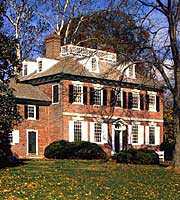
|
|
The Corbit-Sharp House Built in 1774 Located in Odessa, Delaware. |
Little Odessa (population 280) sits right at the pivotal point in this transformation. Here is the very narrowest point of the peninsula between Delaware and the Chesapeake bays. In the Seventeenth Century, there was only a five-mile portage from the head of one creek to the head of the other; the town there was called Cantwell's Bridge. Just why the two Delaware-Chesapeake canals were built a few miles further North is an engineering question, but they tended to shelter Cantwell's Bridge from Northern influences. The neck was so narrow, however, that the road couldn't avoid the town, and for a century it was a pleasure to find a little Colonial town, a little Williamsburg so to speak, popping up among the fields of clover bordering a drive to Dover. A few miles to the West, a very fine boy's boarding school adds to the tone of the place, and it's only a short 9-mile commute to the University of Delaware. The finest 18th Century country house, the Corbit-Sharp House sets the tone for the area, and Christmas season in Odessa is quite memorable. Rodney Sharp was the son of the local school teacher who acquired financial substance, private jet airplanes and all that, on the other side of the canal, and then restored his old home the Corbit house into the Corbit Mansion, bringing the whole farm village up to an elegant level. A visit to Odessa at Christmas, touring the open houses and visiting the festivities, is well worth the trip.
You have to hold your breath to see what is going to happen to real estate in the area. The toll road sweeps around the edge of Odessa, and now the people going to the slot machines and the beaches can hardly see it as they race past. But that's mostly weekend traffic, and during the week all of those cornfields are quickly turning into easy commuter villages, full of McMansions. They are going to fill up the schools, demand better ones, demand traffic signals to protect the kiddies, demand retail outlets for all those upscale stores with catalogers, demand to be noticed. Eventually, all those three-car families will choke up the toll-road, and it will become a great big congested parking lot at rush hour. Sad.
One final comment about the origin of Odessa. It's named after the city in Russia because both of them were wheat exporting cities at one time, although it is doubtful if they were ever comparable in the steamy nightlife. However, the one in Delaware is actually the older of the two. Cantwell's Bridge, Delaware was founded in 1731. For reasons unclear, its name was changed to Odessa in 1845, perhaps in the mistaken idea that the Russian city was where Odysseus once landed. That's what many Russians claim, but the place they have in mind was really in Bulgaria. The place the Russians call Odessa was founded by Catherine the Great in 1794, some sixty years after Cantwell began collecting toll at his bridge in Delaware. When the Bulgarian mistake was pointed out to Catherine the Great, she wouldn't change the name; she sort of liked it that way.
Pea Patch Island
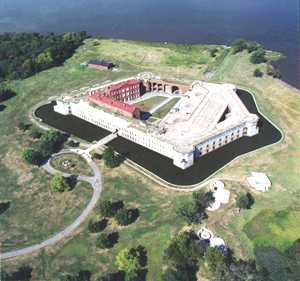
|
| Fort Delaware |
There's a tradition that a boatload of peas ran aground on the mudflats of Delaware Bay near Salem in the Sixteenth Century, turning the flats into a patch of peas. In any event, the island is known to have been growing in size for centuries, and now is home to about 12,000 families of Herons. The number of mosquito families has not been accurately counted as yet, but they are even more numerous. The island doubled in size when the Army Corps of Engineers built the present Fort Delaware on it in 1847-59.
The War of 1812, which included the burning of Washington DC and bombardment of Baltimore, propelled America into a frenzy of coastal defense, and the first fortification of Pea Patch Island took place in 1813. A plan was adopted by Congress in 1816 to build 200 coastal forts, and about forty of them were actually completed by the time of the Civil War. These forts all had a similar appearance; the most notable example of the style was at Fort Sumter near Charleston, South Carolina, which was nearly complete by the time of its famous bombardment. In fact, it was first hastily occupied by Northern defenders arriving just in time to be evicted. In essence, these forts were huge walls of bricks with a concrete outer shell, holding a couple dozen very large cannons and a parade ground.
The new river defenses of Philadelphia were to be provided by three forts, Fort DuPont at the mouth of the old Delaware-Chesapeake canal, Fort Delaware on the island, and Fort Mott on the New Jersey side. You can now take a ferry ride to all three, between April and September; it's a pleasant afternoon excursion. Not so many years ago, you had to go into an ominous little taproom in Delaware City and ask in a loud voice if someone wanted to take you to Pea Patch in a fishing boat. The scene was reminiscent of old movies about derelicts hanging out in Key West, complete with George Raft and Ernest Hemingway, but now the National Park Service has given it the characteristic NPS spruce-up, with pamphlets and restrooms.
The place never had any serious military activity except when it was used to house Confederate prisoners after the Battle of Gettysburg. Over 12,000 prisoners were brought there, and there were about 3000 deaths among them. Historians have compared the treatment of Confederate prisoners with the treatment of Union prisoners at Andersonville, Georgia, and it would be hard to say which place was worse. There are certain diseases of poor sanitation, like typhoid, cholera, amoebic and bacillary dysentery, and hepatitis, which decimate all concentration camps at all times. And adding to them the mosquito-borne diseases of both Delaware and Georgia at the time, you don't really need to assert prisoner mistreatment to account for the morbidity and mortality. Undoubtedly there was some of that.
Elizabethan Accents in Philadelphia

|
| William Shakespeare |
The following is nearly verbatim recounting of a conversation which took place in Philadelphia, between two Philadelphians, in the year 2006, Elizabeth II reigning. The scene is the dressing room for the basement exercise area of a private club. There are about forty stalls for members to hang up their clothes before going into the gym. Although clothes are usually seen hanging in no more than three or four stalls, on this particular day there was only one empty stall, at the far end of the long corridor.
FIRST STRANGER: Well, we certainly have a lot of athletes in the club, today.
SECOND STRANGER: You're very generous with that description of our members.
FIRST STRANGER: Perhaps I ought to call them athlete-wannabees.
SECOND STRANGER: Yes, that's apt.
(Exeunt)
Shakespeare would have expressed it a little better, but anyone can recognize in this little exchange, the elements of those short interlude scenes in Shakespearean plays. The bit players create brief background while the stagehands shift scenery between major acts. Nobody actually has an Elizabethan accent these days, but in Quaker and Upper-Crust Philadelphia circles, the Elizabethan manner of speaking pops out at odd moments, as a coded way of asking strangers, "Are you a native Philadelphian? You sort of look like one." If the stranger doesn't seem to grasp the idea, well, let it pass.
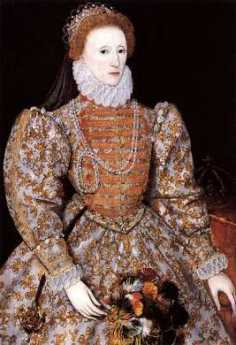
|
| Elizabeth I |
In the more remote sections of the Delmarva peninsula, it is claimed the natives often do speak in a pure Elizabethan accent. Somehow I am dubious of that, having listened for it over sixty years of travel in those regions. Rural Delaware talks with a softened version of a Southern accent, even softer than you hear in Tidewater Virginia. It's hard to believe that Marlowe and Shakespeare talked like that. But go into a roadside coffee shop and listen to the truck drivers joshing the waitress; it's not an accent but an Elizabethan manner of address that's recognizable. They self-consciously stop talking that way when obvious strangers come into the shop.
Because of Dr. Samuel Johnson's dictionary, Shakespearean adjectives pepper English speech in all regions of the world. Johnson was a theater critic in his early days, so when he needed familiar quotations to illustrate the words in his dictionary, he drew heavily from Shakespeare. William Shakespeare's tendency to invent likely vocabulary was thus enshrined by Johnson's dictionary as
New Castle, Delaware
New Castle is easy to get to, but hard to find. It's right on Delaware Bay, at the start of the old National Road (Route 40), next to two huge bridges, a few miles from the main north-south turnpikes, a couple of miles from an airport -- and lost in a sea of suburban housing and highway slums. It's lost, so to speak, in plain sight.
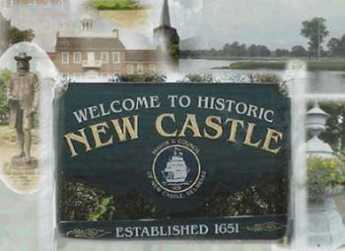
|
| New Castle, Delaware |
And yet it is a perfect jewel of early American history and architecture. It's just as attractive and historically important as Williamsburg, Virginia, except these buildings are not reproductions, but the real thing. The town says it was founded in 1651 by Peter Stuyvesant, but Peter Minuit in 1638 could make a claim to be even earlier. Located at the narrow neck of the funnel that is Delaware Bay, it was a natural place to start a colony, eventually to be the capital of the state. The Delaware River makes a rightward turn at that point, and creates a river highway all the way to Trenton. But a few miles upriver at Tinicum, now Philadelphia International Airport, the river started to fill up with islands and snags; was it better to locate upriver or downriver from the narrows? New Castle was placed downriver.
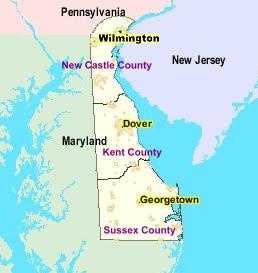
|
|
New Castle's courthouse is the epicenter of the arc from Maryland to the Delaware River. |
But in 1777 the British fleet came to visit with hostile intent, and New Castle could look out the windows along the Strand right into the mouths of ships with twenty or thirty cannons pointing at them. Philadelphia, on the other hand, was protected upriver by a series of mud flats and barricades at Fort Mifflin that could quite effectively bar passage to enemy sailing ships. Delaware got the point, and shortly thereafter, the capital of Delaware was prudently moved to Dover, while even the county seat of New Castle County was moved to Wilmington. New Castle had a big fire in 1824; rebuilding afterward accounts for much of the present uniformly Federalist architecture. The final nail in the commercial coffin of the town was driven by the Pennsylvania Railroad, which just by-passed the town. For a century, this little architectural jewel just sat there in the fields, until the narrow neck of the Delmarva Peninsula became such a transportation crossroads that the fields filled up with construction more appropriate to Los Angeles. New Castle disappeared, without moving an inch.

|
|
100 Harmony St., New Castle, DE 19720 (302) 328-2413 |
For fifty years in Colonial days, the rector of Immanuel Episcopal Church in New Castle was one George Ross. His son, also named George Ross became a lawyer in Lancaster and signed the Declaration of Independence. His widowed daughter, Gertrude Ross Till married George Read, a lawyer in New Castle who also signed the Declaration. And, a third signer Thomas McKean, lived two houses away. George Read had studied law under John Moland, whose house served as Washington's headquarters in 1777.
The northern border of Delaware is a semicircle, with a twelve-mile radius based on the cupola of the New Castle courthouse. It was originally the border of New Castle County, and it proved to be slightly imperfect. In the first place, it extended across the Delaware River into New Jersey, but it was a nuisance to go there, so that segment of land was abandoned to New Jersey. However, the legal border of the State of Delaware, therefore, extends to the high-water bank of the river on the New Jersey side, rather than running down the middle of the river. The significance of this curiosity appeared when the Delaware Memorial Bridges were built, and all of the tolls go to Delaware, instead of being split between the states as is more customary. The other problem with the semi-circular arc was that three lines meet at the northwestern corner of Delaware, and each was defined in its own way. The Mason-Dixon line goes due east-west, the border with Maryland goes north-south, and the idea was that the semicircular arc would meet the other two lines at a point. However, the instructions could be read in two different ways, leaving a little "wedge" of territory that could be reasonably said to lie in either Pennsylvania or Delaware, depending on the sequence of describing them. This was certainly a circumstance where any decision was better than no decision, but it took until 1921 for the states to harrumph their way to a final pronouncement. In the meantime, the disputed wedge of land was a good place to have duels, cockfights and other matters of questionable legality.
REFERENCES
| Lewes, Delaware: Celebrating 375 Years of History Kevin N. Moore ASIN: B006DL8TC6 | Amazon |
Caesar Rodney Rides Through the Rain
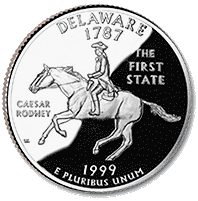
|
| Caesar Rodney |
If you have a quarter minted in 1999, you can see a depiction of Caesar Rodney riding through the rain, mud and heat, all night, to cast his July 2 vote for independence at the 1776 Continental Congress. There are no known painted portraits of Rodney, probably because his face was badly mutilated by cancer which ultimately killed him.
On July 1, Thomas McKean and George Read had split Delaware's votes in a tie, and McKean had urgently sent word to Rodney, the absent third vote, that he must come to Philadelphia quickly. Rodney was suffering from cancer. It may thus have been Thomas McKean's idea to invoke the concepts of the Treaty of Westphalia to escape hanging for armed rebellion, but Ben Franklin seems more likely. Once an idea like that gets started in a gathering, it quickly becomes everyone's idea. But Franklin was the only one to stampede a group and take no credit for doing so.

|
| Rodney |
Schoolchildren in Delaware can be forgiven for asking why Rodney wasn't in Philadelphia for the vote without being sent for. And we don't really know. Rodney certainly had plenty of other things competing for his attention, like being a Supreme Court Justice, the Speaker of the Delaware Assembly and the de facto Governor of the State, as well as being a Brigadier General in the Militia (he later was made Major General in charge of the garrison at Trenton). One has to suspect, however, that he had not expected George Read to vote against independence. Read, after all, had married the widowed sister of George Ross, who did sign the Declaration.
Asthma, a notoriously intermittent condition, may have been a worse impediment to Caesar Rodney's ride than his cancer. Although he was badly disfigured, cancer did not kill him until 1784. The prospect of riding eighty miles in the rain with asthma may well have been the reason Rodney held off until he was absolutely certain his vote was needed. The esteem and affection that Delaware holds for this farmer from Dover can be gauged by the fact that he remained the elected speaker until the day he died, and during his last three months, the legislature held its meetings in his house so he could be present.
Pennyslvania's Boundary: David Rittenhouse, Hero, Lord Baltimore, Villain
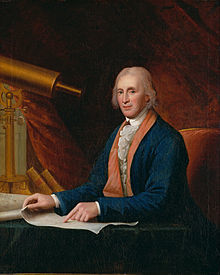
|
| David Rittenhouse |
In the Twenty-first Century, when we know how every American creek and river run, we can see it might have been simple to establish a boundary between the new royal grant to William Penn, and an earlier grant to Lord Baltimore by the then-reigning king's father, Charles I. Essentially: Penn got the Delaware Bay and a lot of wilderness to the west of it. George Calvert, Lord Baltimore, had long held the top half of the Chesapeake Bay and a strip of wilderness to the west of that. Two bays, with two hazy strips of wilderness attached.
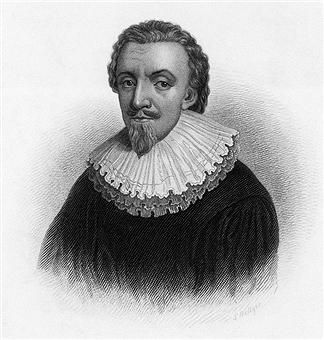
|
| George Calvert, Lord Baltimore |
At what is now Odessa, Delaware, those two bays are only five miles apart; compromise should have settled the issue quickly. Two English gentlemen could have sat down over a pipe and a brew, working something out. However, the English nation was then changing kings, beheading them over matters of religion. A Roman Catholic, Lord Baltimore probably thought an opportunity might emerge from the turmoil if he stalled until matters went his way, since next in line of succession was James, Duke of York, who was a Catholic. But matters fall into the hands of the lawyers when principals of an argument are unable to speak. As we noted elsewhere, in the legal system of the day the last word from the last king was what counted in law courts, accepting any uncertainty about future latest words from future latest kings in order to maintain immediate peace. To lawyers of the time, all this talk about justice, fairness, and geometry was idleness when the nation needed order and stability. So the Calvert family lawyers over the course of eighty years, introduced one specious proposition after another that turned other lawyers purple with rage. Penn's lawyer, Benjamin Chew, beat them at this game, and his mansions in Delaware and Germantown attest to the value attached to this achievement. In other circumstances, posturing might have led to war, as it did in similar disputes with Connecticut. Penn probably knew better, but it takes two to compromise.
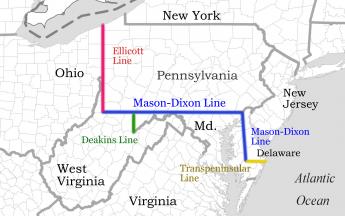
|
| Mason-Dixon Line |
It must be admitted that honest confusion was possible. Sometimes, a line of latitude was a line in the sense Euclid intended: all length and no width. At other times, lawyers and kings were talking about "parallels" as if they were strips, roughly sixty miles wide. If a sixty-mile strip was intended, it was important for a grant to specify whether it extended to the southern edge of the strip, or to the northern edge. But in fact, the state of science in the Seventeenth Century contained uncertainty about both where the strips were, and how wide. And if the grant's language didn't even make it clear whether the parties were talking about strips or width-less lines, eighty years could be a comparatively short time for a court to decide the case. To be fair to Lord Baltimore, many people at the time didn't think these matters were capable of fair solution, so the traditional way of dealing with land disputes was either by force or by craftiness.
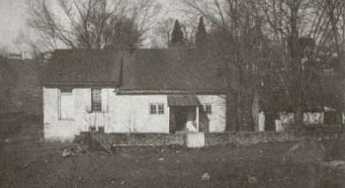
|
| David Rittenhouse Birth Place |
In William Penn the folks from Maryland were, unfortunately, dealing with a friend of the King, who had one of the most brilliant mathematicians in Western civilization as his adviser. David Rittenhouse may have been born in that little farmhouse you can still visit on the Wissahickon Creek, and made his living as a clockmaker, but his native talents in mathematics, astronomy surveying, and instrument construction were so deep and so varied that later biographers are reduced to describing him merely as a "scientist" and letting it go at that. If you want to sample his talents, spend an hour or two learning what a vernier is, and then see if you could apply that insight, as he did, to a compass. So, as it turned out, Rittenhouse was able to describe a twelve-mile circle around New Castle, Delaware, construct a tangent that divides the Delmarva's Peninsula in half, and match it up with an east-west line we now call the Mason Dixon Line. When they finally got around to laying these lines on the ground, Mason and Dixon cut a twenty-four-foot swath through the forest, using astronomical adjustments every night, and laying carved marker stones every fifth of a mile for hundreds of miles. The variation from the line devised by Rittenhouse was at most a fifth of a mile off the mark; the intersection with the north-south line between Maryland and Delaware was less successful. The survey by Mason and Dixon was not quite completed to the Ohio line because the Indians, curious at first, eventually became wild with suspicion at such behavior, particularly the part about going out and aiming cannons at the sky every night. It seems likely that George Calvert, Lord Baltimore, had no more confidence in this madness than the Indians did.
So, the next time you take the train from Philadelphia to Washington DC, reflect that strict reading of the words in the land grants did admit the possibility that your whole trip could either have been within the State of Maryland, or else in the Commonwealth of Pennsylvania, depending on whether lawyers, or scientists, had triumphed in this dispute. Since the Mason Dixon Line later divided not merely two states, but two violently opposed cultures, Rittenhouse must stand out in the history of one of those people who were so smart that most people couldn't understand how smart he was.
Brandywine Museum
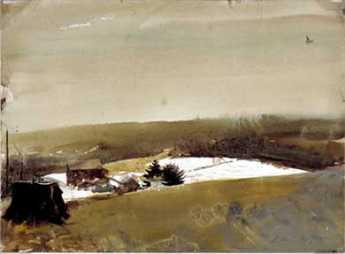 |
| Wyeth Ann's House |
Artistic talent must be inherited; some of us don't have any at all, while other families seem to have unusual talent in every member. Around Philadelphia, one notable example is the Peale family, and another is the Wyeth clan. Three generations of Wyeth's show their work as a group in a former Brandywine Creek grist mill which has been elaborately restored and enlarged for the purpose. Using large glass windows, part of the display is the Brandywine Creek itself, with the high banks that once made it seem like a perfect defense line for George Washington in the biggest battle of the Revolutionary War. Outside the museum entrance are several of those inevitable Delaware tip-offs, large millstones that may in this case have ground grist, but often were used to grind gunpowder.
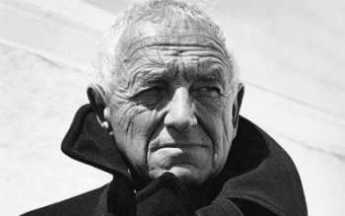 |
| Andrew Wyeth |
Andrew Wyeth spent much of his early career doing watercolors and then turned to tempera as re-popularized by N.C. Wyeth, his father. That's a fairly drastic change, since a watercolor must be completed in one sitting before it dries. Oil base paint dries slowly and allows the painter to work on a piece for a number of days. Tempera, using the protein in milk and eggs to hold the pigment, dries hard and fairly quickly. But another layer of tempera can be painted on top of the hardened base layers, making a glowing effect possible, a peculiar luminosity if the artist chooses to bring it out. Andrew Wyeth migrated to what he called dry-brush, where the paint on the brush is mostly squeezed out, so extremely detailed fine lines can be painted. Thus, he spent his early years with fast blurred watercolors, and the rest of his life with meticulous slow painting, where detail is everything. He chose to use this technique to produce a haunting silent scene, even if it contained people. His son, Jamie, tends to emphasize dancers so you can see the typical family rebellions alternating between generations, at the same time that the Wyeth's (and Howard Pyle, the artistic forefather) preserve strong family unity. From what the neighbors say, there were plenty of family clashes, but that's artists for you.
Greenwich, Where?
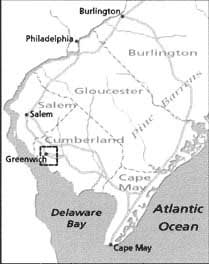 |
| Greenwich NJ |
If you sail north up the Delaware Bay, you would go past Rehoboth, Lewes, Dover, New Castle, Wilmington -- on the left, or Delaware side. On the right, or New Jersey side, it's a long way from Cape May to Salem, the first town of any consequence. That is, the Jersey side of the riverbank is still comparatively uninhabited. When the first settlers came along, with vast areas to choose among, it might have seemed attractive to settle on the Delaware side, because the peninsular nature of what is now called Delmarva (Del-Mar-Va) would provide land access to two large navigable bays, the Delaware, and the Chesapeake. To go all the way up the Delaware to what is now Pennsylvania would give trading access to a whole continent, so that eventually proved to be where immigration was headed. But as a matter of fact, the marshy Jersey shore seemed more attractive for settlement by the earlier settlers.
A settler has to think about starving the first year or two, because trees have to be cut down, and stumps pulled up before the land can even be plowed. After that, comes planting and growing, then finally harvesting. Trees, behind which Indians can hide, are a bad thing all around in the eyes of a settler. The flat swampy meadows of the Jersey bank were just exactly what the Dutch knew how to manage. Dam up the creeks and drain the ground, and you will soon have lots of lands ready for the plow, without any confounded trees. By the end of the seventeenth century, the English who had made the mistake of settling in rocky Connecticut finally saw what the Dutch were able to do, and came down to take it away from them.
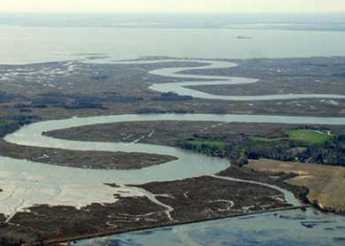 |
| Greenwich scenery |
That's why there is a Salem, New Jersey, and also a Greenwich, New Jersey. Greenwich ( around here they pronounce it green-witch) had 870 residents at the last census. It is one of the cutest little colonial villages you are likely to encounter. The local historians refer to it as an unreconstructed Williamsburg, drawing prideful attention to the fact that these houses were really built in the colonial period, and are in no way imitation reconstructions. The isolated charm of this place is in large part due to being surrounded by a maze of wandering creeks, so visitors by land travel don't get there in time for lunch unless they take great care to follow a local road map. If you arrive by water, it's no problem; just navigate up the crooked and twisting Cohansey River.
Although pioneer settlement was much earlier, the oldest house still standing in that rather damp area was built in 1730. Things are pretty much the way they were before the American Revolution because the Calvinists who settled here were not prepared for the Jersey mosquito, which obviously is abundant in such a marshy area. With the mosquito comes relapsing (Vivax, malaria, black water (Falciparum) malaria, and Dengue Fever (graphically known locally as break-bone fever). As a matter of fact, encephalitis is also mosquito-borne. When you don't understand the insect carrier situation, survival in such an environment depends on local fables and lore, like going to the mountains for the summer after the planting season, and only returning at harvest time. That sounds to a New Englander newcomer like a superstitious cloak for lazy living, especially since masses of fish come up the river in teeming waves, looking for mosquitoes to eat. So, Greenwich is charming, but it never was thriving.
Working hard to find something to say about the town, it would appear that Paul Revere himself came riding into Greenwich in December 1774, urging the town to join their Boston relatives in the destruction of tea belonging to the British East India Company. Greenwich accordingly had a public tea burning on December 22. Since the more notorious Boston tea party took place on December 16, 1773, and the British Tea Act was passed in May, 1773, it is not exactly accurate to say the rebellion spread like wildfire. One has to suppose that the inflammatory tale told to the local farmers by Paul Revere was likely a little enhanced, since a careful recounting of the events in Boston suggests a number of ways the uproar might have been avoided if Samuel Adams and his friends had been less provocative. Or if Massachusetts Royal Governor Thomas Hutchinson had been less flighty. Or for that matter, if Benjamin Franklin had restrained himself when he got hold of Hutchinson's letters at a critical moment when he was in London. In retrospect, the best model for behavior was provided by the Royal Navy; the whole Boston Tea Party was surrounded by armed British naval vessels, who did not lift a finger throughout the demonstration.
Anyway, little Greenwich had its minute of fame with a tea burning. Otherwise, it has had a very quiet existence for three centuries.
REFERENCES
| Paul Revere & The World He Lived In | Amazon |
The Final Capture of Philadelphia (6)
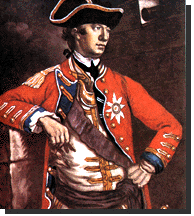
|
| General Howe |
Philadelphia had only 25,000 inhabitants during the Revolutionary War. Now, nearly that many British soldiers of Sir William Howe poured into town, victorious. Victorious, except for being cut off from their supplies on the warships in the Chesapeake. Men war soon sailed up the Delaware River but found the narrow channel between Fort Mifflin and Fort Mercer in New Jersey blocked by strange contraptions called chevaux-de-frise. These instruments consisted of heavy timbers sunk to the bottom of the river, containing massive iron prongs that reached almost to the surface but pointing downriver. They were effective blocks to wooden vessels, almost impossible to dislodge. The general arrangement was: Fort Mercer on the top of the New Jersey cliff called Red Bank (now National Park), overlooking the blockaded channel. On the other side of the ship channel, Fort Mifflin on an island. A second channel between Fort Mifflin's island and the Pennsylvania shore was quite shallow, allowing special American gun barges and galleys to come down and attack the larger British vessels, then to escape pursuit by fleeing upstream. The Americans had two years to perfect this defense, and it was formidable. Only one or two large sailing vessels could maneuver near it downriver, and at least the Pennsylvania side was difficult to attack across the mud flats.
When Howe was earlier considering how to attack Philadelphia as he sailed Southward past the mouth of Delaware, he had decided it was hopeless for his fleet to attack this barrier if it was defended by an army, and the strategy evolved to defeat Washington, first. However, in the event, Washington's Army remained essentially intact after the conquest of the city, and from Valley Forge was able to interfere with supplies from the Chesapeake or lower Delaware Bay, but still send reinforcements to the river defense. The communication line on the Westside was essentially what is now the Blue Route, the third side of a triangle, from Conshohocken to Fort Mifflin, containing all of the British troops. The bend in Delaware made two sides of this triangle, and turbulence created by the river bend threw up mud islands which made the channel particularly narrow. These islands have since been filled in for the airport, the stadiums and the Naval yard, so the battleground is today, unfortunately, a little hard to make out, just as is also true of Bunker Hill, North Church, etc. in Boston Harbor.
Four or five hundred Americans were in each of the two forts, and eventually, most of them were wiped out, at least half of them by starvation and exposure as much as cannon and musket fire. They had British on both sides of them, heavy guns bombarding them, under attack for weeks. The British kept at it because to fail meant the loss, by starvation and snipers, of almost the entire British expeditionary force in America. A contingent of Hessians under von Donop was sent to Haddonfield and down the King's Highway to attack Fort Mercer from the rear. In a moment famous in Haddonfield, a champion runner named Jonas Cattell sneaked out of the town and ran to Fort Mercer to tell the troops to turn their guns around for an attack from the rear but lie concealed behind the guns, while meanwhile the Quakers in the little town entertained the Hessians in a very friendly way. There was more to it than that, with some heavy fighting in the open, but von Donop and most of his troops were casualties. The fort had been made smaller in the past, unexpectedly presenting the attackers with a second set of fortifications after they surmounted the outer ones. Later on, a second assault by a different contingent of Hessians did level the Fort. If not, there would have been a third or a fourth assault, because a river passage simply had to be forced to relieve starving Philadelphia. Before the repeated assaults were over, Fort Mifflin had also been bombarded into rubble. But what really carried the day for the British was the late realization that if small Americans boats could sneak down the channel on the Pennsylvania side of Mifflin; then small British boats could go the other way, as well. Although the river blockage was eventually broken, it took six weeks after the battle of Germantown, and meanwhile, the heroic defense did a great deal to rally the sympathies of what had been considered maybe a loyalist city, and partly loyalist Colony of New Jersey. Before the winter was over, Howe had to go back to London to explain himself, being replaced by General Clinton, who was much less clever and much more provocative as a conqueror. The first two years had British control by a minority of hothead aristocrats. For the remaining five years of the war, the sobered British concept was no longer liberation of colonial Tories, but the subjugation of fanatic Rebels. The realization gradually spread, through both England and America, that the war had been lost, since Independence was a more sustainable situation for everyone than continuing endless efforts at subjugation.
The Proprietorships of William Penn
William Penn became first interested in the Colonies when he acquired New Jersey as an investor in what started out as the bankruptcy proceedings of a client. Unlike his spoiled children and grandchildren, he was sincerely interested in helping the persecuted members of his new religion, and those who later totaled up his lifetime finances found that overall he lost money on his real estate ventures. His descendants, however, were mainly concerned with selling real estate, and soon reverted to Anglican church membership. When William Penn later received Pennsylvania and Delaware from the King of England (Charles II, the Stuart King restored with the help of his Admiral father), he not only owned these territories but for practical administrative reasons was offered the right to rule them. By then Penn's main future intention was to found a refuge for Quakers and other religious dissenters, so becoming a vassal King was graciously declined. Instead, he became a real estate Proprietor, after satisfying himself about the government and other arrangements in only a general way. At least half the original 13 colonies were also proprietorships, although the terms of their grants had great variation. Penn's intention for the proprietorship was to sell off as much of the property as possible, sort of benignly watching the process unfold in the parts he had sold.
There were two unforeseen flaws in this benevolent idea; the first was that his sons and heirs would abandon the Quaker faith and have little interest in his holy experiment except for the revenue it returned. The second flaw was to fail to see that vigorous religious toleration might eventually lead to the Quakers becoming outnumbered in their own refuge. Eventually, there does come a time in the real estate sell-off process when you have sold more than you retain. After that point, you may no longer dominate the politics, and in fact, that happened far sooner than half-way, because of Penn's unwillingness to employ force .
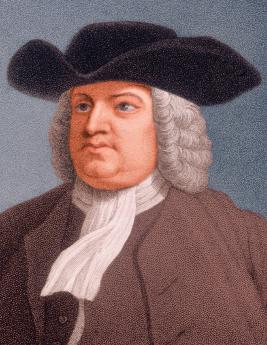
|
| William Penn |
In land value, although perhaps not in land area, that point of loss of control had been reached by the middle of the eighteenth century, and it led to a famous battle between the Penn descendants and Benjamin Franklin. The Penn family saw no justice in paying taxes on the land they hadn't yet sold, or obeying laws created by their customers which extended beyond the land they owned; if they wanted to rule it all, they should buy it all. Franklin took the part of the settlers and immigrants, who resented paying taxes and fighting Indians on behalf of someone who still owned vast stretches of the land "within" the colony. A significant factor in this peculiar argument is that Thomas Penn, the dominant chief of the family descendants, had a deep and abiding suspicion of Franklin, dating back to that episode related in Franklin's Autobiography where Franklin raised a militia in King George's War when the pacifist Quakers refused to do so. Both sides had some justice in their positions, both sides appealed to the King. The Penns knew the King better, so Franklin lost. That was mostly what Franklin was doing in London in the years before the Revolution, and eventually, it took a Revolutionary war to resolve the issue. Some have said the episode showed Franklin was not as shrewd a politician as history books would portray him. In fact, it more likely emphasizes that Franklin was a loyal British subject right up to 1775. His position was that all parties were and forever would be, inhabitants of the British Empire, so they had equality under British rule. The Penns felt they had a right to consider Pennsylvania their own sovereign property, under which the colonists had no rights until they paid for them. It is easy to see how the notion of independence could take hold in this curious reversal of roles. Nevertheless, Pennsylvania did resolve the issue with the appearance of lawfulness, although with restrained generosity. To quote Sydney G. Fisher, writing in The Quaker Colonies, "When the people could have confiscated everything in Pennsylvania belonging to the proprietary family, they not only left them in possession of a large part of their land but paid them handsomely for the part that was taken." The matter is generally considered to have been finally settled by the Confirming Act of 1787, although few would now contend that fifteen pennies per acre is or was a handsome price.
And so, the Pennsylvania proprietorship was dissolved. In New Jersey, on the other hand, the proprietorship still exists. The land between the North River (Hudson) and the South River (Delaware) was divided into two proprietorships by a line drawn between the Delaware Water Gap, and Beach Haven on Long Beach Island. The southern segment was called the Proprietorship of West Jersey, informally peopled by English Quakers, and a northern half, the Proprietorship of East Jersey, informally ceded to Scots Quakers who proved to be more Scottish than Quaker. Temperamental differences might well have eventually led the two segments to take opposite sides of the 1860 Civil War except that it was the northern half that sympathized with slavery and the Southern Confederacy, while the Proprietorship of West Jersey was mostly where the anti-slavery movement began, with a Quaker named John Woolman. As matters turned out, neither slavery nor taxing unsold land became irreconcilable issues in the Jerseys. Unsold land of the Proprietorship was already fairly minor in New Jersey at the time of the Revolution, but the issue hadn't been forgotten by the Proprietors, either. A couple of the stockholders of the proprietorship were members of the Constitutional Convention. When the time came that other delegates urgently needed New Jersey's vote to ratify the new constitution, the Proprietor problem was "explained" to the other states. The outcome was that the proprietorship tacitly agreed to be taxed and regulated like any other property owner, while their own rights were respected as persisting under the new Constitution. Such a sensible outcome was probably not possible in Pennsylvania because there was so much more unsold land to fight about. The peacefully accepted consequence in New Jersey, even today, is that when the ocean creates a new strip of beach or a farmer abandons some land on the other side of a turnpike, it reverts to the Proprietorship as undeeded and untitled land. As such, it legally belongs to a little group of stockholders who meet once a year in Burlington or Salem, under a tree, and who can actually pay themselves annual dividends. It is however only true in half the state; the Proprietorship of East Jersey surrendered its rights to the State in 1998.
In Delaware, things are a little fuzzier. Delaware was once part of Pennsylvania, as its lower three counties. John Dickinson was once Governor of both states, but they had two legislatures from 1700 to 1776. The last time the proprietorship matter came up, so far as real estate lawyers can remember, was in the shifting sandy beaches of Cape Henlopen; things were smoothed out by making the disputed land into a state park.
REFERENCES
| Encyclopedia of New Jersey | Google Books |
| The Problem of West Jersey | JSTOR |
| The Oxford History of the British Empire: The Origins of the Empire | Google Books |
| A Map of East and West New Jarsey | JPG |
| Council of Proprietors of West Jersey | westjersey.org |
| Magna Charta: Part I: The Romance of the Great Charter; Part II: Pedigrees of the Barons: John S. Wurts: SIN: AB0006D91C4 | Abe Books |
| West New Jersey: The Peculiar Province: ASIN: B00072HGTE | Amazon |
| Why the Private School?: Allan V. Heely: ASIN: B000GR1QS2 | Amazon |
Riverline: Camden and Amboy Revival
The RiverLine, a sort of diesel-powered overgrown trolley car line, has just opened on the Conrail tracks from Camden to Trenton. It runs every 30 minutes in both directions but unfortunately stops at 10 PM to let Conrail run freight trains at night. That's almost a perfect fit for the two operations, although it can leave baseball fans stranded at a night game at Campbell Park, or concertgoers at the Tweeter Center. The trains are running fairly full, partly because of their novelty, and partly because of the initial decision not to collect the $1.10 fare on Sunday, but mostly because the Riverline proved to be a better idea than anyone realized it would be. It's considerably cheaper for Philadelphia commuters to Wall Street to take the Riverline and transfer to New Jersey Transit at Trenton, for one thing. Even Amtrak encourages that, because high gasoline prices have filled up the Amtrak trains.
It's well worth a historical excursion on the RiverLine, which runs on the former right of way of the Camden and Amboy RR, the first railroad in New Jersey, chartered in 1830 by Robert L. Stevens. A genius of many talents, Stevens invented the iron rail which looks like an inverted "T," held in place by a system of plates and broad-headed spikes. The system is still in use today. Stevens also devised the use of wooden cross ties rather than granite ones, finding they resulted in a smoother ride. In 1834, he joined forces with another many-talented genius, Robert F. Stockton, who had earlier constructed a canal from New Brunswick to Trenton. Stevens then built a railroad beside the canal, subsequently extending it from Trenton to Camden. Stockton ran ferry boats from Perth Amboy to New York, and from Camden to Philadelphia. The full trip from New York to Philadelphia took nine hours, a remarkable improvement over the horse-drawn competition. The partnership also got the Legislature to confer monopoly rights, so the arrangement was highly profitable as well as an engineering marvel. Sixty years later, the Sherman Act would declare such monopolies to be crimes, but in 1830 they were considered a clever way for Legislatures to stimulate risky investment. The Pennsylvania Railroad bought the partnership and its monopoly in 1871, but preferred to bridge the Delaware River at Trenton, so the towns and track along the Jersey side of the river soon dwindled away. The RiverLine now provides a pleasant one-hour excursion along the riverbank, down the main streets of some cute little towns, past some remarkable woods and wilderness up near Trenton, and past Camden's urban revival at the other end.
Battleship New Jersey: Home is the Sailor
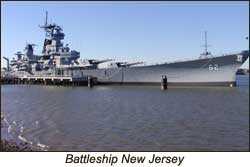
|
Home is the sailor, wrote A. E. Housman, Home from the sea. In this case, the sailor is the Battleship New Jersey. The U.S.S. New Jersey rides at permanent anchor in the Delaware River, tied to the Camden side. You can visit the ship almost any afternoon, and with reservations can even throw a nice cocktail party on the fantail. It's an entertaining thing to do under almost any circumstances, but the trip is more enjoyable if you spend a little time learning about the ship's history. The volunteer guides, many of them still grizzled veterans of the ship's voyages, will be happy to fill in the details.
In the first place, the ship's final bloody battle was whether to moor the ship in the Philadelphia harbor, or New York harbor, when the U.S. Navy had got through using it. You can accomplish that and remain in the state of New Jersey either way, but there's a big social difference between North Jersey and South Jersey, so the negotiations did get a little ugly. Because of the way politics go in Jersey, it wouldn't be surprising if a few bridges and dams had to be built north of Trenton to reconcile the grievance, or possibly a couple of dozen patronage jobs with big salaries but no work requirement. The struggle surely isn't over. Battleships are expensive to maintain, even at parade rest; if you don't paint them, they rust. Current revenues from tourists and souvenirs do not cover the costs, so the matter keeps coming up in corridors of the capitol in Trenton.

Home is the sailor, home from sea:
Home is the hunter from the hill:
'Tis evening on the moorland free, 
|
|
A. E. Housman
R.L.S. |
Battleship design gradually specialized into a transport vehicle for big cannon, ones that can shoot accurately for twenty miles while the platform bounces around on the ocean surface. Situated in turrets in the center of the vessel, they can shoot to both sides. That's also true of armored tanks in the cavalry, of course, with the history in the tank's case of the big guns migrating from the artillery to the cavalry, causing no end of a jurisdictional squabble between officers trained to be aggressive for their teams. Originally, the sort of battleship which John Paul Jones sailed was expected to attack and capture other vessels, shoot rifles down from the rigging, send boarders into the enemy ships with cutlasses in their teeth, and perform numerous other tasks. In time, the battleship got bigger and bigger so in order to blow up other battleships had to sacrifice everything else to sailing speed and size of cannon. Protection of the vessel was important, of course, but in the long run, if something had to be sacrificed for speed and gunpowder, it was self-protection. There's a strange principle at work, here. The longer the ship, the faster it can go. Almost all ocean speed records have been held by the gigantic ocean liners for that reason. If you apply the same idea to a battleship, the heavy armored protection gets necessarily bigger, and heavier as the ship gets longer, and ultimately slows the ship down. As a matter of fact, bigger and bigger engines also make the ship faster, until their weight begins to slow them down. Bigger engines require more fuel and carrying too much of that slows you down, too. Out of all this comes a need for a world empire, to provide fueling stations. Since the Germans didn't have an empire, they had to sacrifice armor for more fuel space and more speed, to compensate for which they had to build bigger guns but fewer of them. Although the British had more ships sunk, they won the battle of Jutland because more German ships were incapacitated. When you are a sailor on one of these ships, it's easy to see how you get interested in design issues which may affect your own future. An underlying principle was that you had to be faster than anything more powerful, and more powerful than anything faster.
The point here is that the New Jersey, as a member of the Iowa class of battleship, was arguably the absolutely best battleship in world history. At 33 knots, it wasn't quite the fastest, its guns weren't quite the biggest, its armor wasn't quite the thickest, but by multiplying the weight of the ship by the length of its guns and dividing by something else you get an index number for the biggest worst ship ever. The Yamamoto and the Bismarck were perhaps a little bigger, but the New Jersey was at least the fastest meanest un-sunk battleship. Air power and nuclear submarines put the battleship out of business so the New Jersey will hold the world battleship title for all time. Strange, when you see it from the Ben Franklin Bridge, it looks comparatively small, even though it could blow up Valley Forge without moving from anchor.
One story is told by Chuck Okamoto, a member of the Green Berets who was sent with a group of eight comrades into a Vietnamese army compound to "extract" an enemy officer for interrogation. When enemy flares lit up the area, it was clear they were facing thousands of agitated enemy soldiers, and Okamoto called for air support. He was told it would take thirty minutes; he replied he only had three minutes, and to his relief was told something could be arranged. Almost immediately the whole area just blew up, turned into a desert in sixty seconds. The guns of the New Jersey, twenty miles away, had picked off the target. The story got more than average attention because Okamoto's father was Lyndon Johnson's personal photographer, and Lyndon called up to congratulate.
A number of similar stories led to the idea that naval gunfire might have destroyed some bridges in Vietnam which cost the Air Force many lost planes vainly trying to bomb, but, as the stories go, the Air Force just wouldn't permit a naval infringement of its turf. This sort of second-guessing is sometimes put down to inter-service rivalry, but it seems more likely to be just another technology story of air power gradually supplanting naval artillery. Plenty of battleships were sunk by bombs and torpedo planes before the battleship just went away. If you sail the biggest, worst battleship in world history, naturally you regret its passing.
Tourists will forever be intrigued by the "all or nothing" construction of the New Jersey. Not only are the big guns surrounded by steel armor three feet thick, but the whole turret for five stories down into the hold is also similarly encased in a steel fortress. This design traces back to the battle of Jutland, where a number of battlecruisers were blown up because the ammunition was stored in areas of the hold not nearly so protected as the gun itself. Putting it all within a steel cocoon lessened that risk, and had the side benefit that when ammunition accidentally exploded, the damage was confined within the cocoon. It must have been pretty noisy inside the turret when it was hit, sort of like being inside the Liberty Bell when it clangs. But not so; stories have been told of turrets hit by 500-pound bombs which the occupants didn't even notice. The term "all or nothing" refers to the fact that the gun turrets are sort of passengers inside relatively unprotected steering and transportation balloon. In order to save weight, most of the armor protection is for the gun. That's a 16/50, by the way. Sixteen inches in diameter, and fifty times as long. With the weight distributed in this odd manner, the Iowa class of dreadnought was more likely to capsize than to sink. Accordingly, the interior of the hull is broken up into watertight compartments, serviced by an elaborate pumping system. Water could be pumped around to re-balance a flooded hull perforation, certainly a tricky problem under battle conditions.
The Victor Talking Machine Company
Thomas Edison gets credit for inventing the phonograph around 1880, but what he invented was a concept of scratching a roll of tin foil with a needle. The approach wasn't really feasible, and Alexander Graham Bell modified it to scratching a wax cylinder. That was somewhat better, becoming the basis for the Dictaphone single-use system which persisted for several decades. But both Bell and Edison went on to more promising things. Meanwhile, a man named Charles Cros wrote an article in 1887, quite astutely describing the whole process we now know as the phonograph record.
Meanwhile, a young machinist from Dover, Delaware was puttering around with various steps in the sound recording process, and in 1900 was ready to find the Victor Talking Machine Company at 10th and Lombard Streets in Philadelphia. But while Eldridge Reeves Johnson had big trouble patenting Charles Cros's prior discovery, he was nevertheless destined to be gloriously successful with Victrola records in ways later Philadelphia inventors were destined to fail, utterly, with the computer. The Patent Office pointed out that while Cros had the theory right, he never even made a working model of his idea. His inaction had no right to be called "prior art", but was more aptly called an "abandoned experiment".

|
| Victor Company |
Johnson, on the other hand, worked out all the many practical difficulties in the road of developing a useful and salable product. The size, shape, and composition of the phonograph needles, the best speed of rotation of the platter, the motors to make it run uniformly, the best way to magnify the sound, the way to create a metal master, from which many cheap wax impressions could be made. And so on, fighting with competitors and patent claimants, just about every step of the way. With the great good fortune to make ten early recordings of Enrico Caruso for a trivial payment, the Victor Company was soon on its way and had to move its plant to Camden, where there was more room to spread out and grow. The Philadelphia Orchestra enjoyed huge financial royalties and climbed into the first rank in world orchestras, greatly facilitated by the near-by convenience of the Victor recording studios. Philadelphia became a music capitol where once it had been a Quaker city that didn't much approve of music.
As things happen in the technology industry, Victrola records were hit hard by the advent of radio, which also largely originated in Philadelphia. Inventories of unsold products suddenly piled up, and poor old Eldridge Johnson was reluctantly forced to sell out to RCA, the Radio Corporation of America. Johnson was paid $23 million to cash out of his business -- in March 1929. If he had waited another six months, his prosperity for a life's work would have been meager.
The Origins of Haddonfield

|
| Haddonfield's Dragon |
Haddonfield, New Jersey is named after Elizabeth Haddon, a teenaged Quaker girl who came alone to the proprietorship of West Jersey in 1701 to look after some land which her father had bought from William Penn. Geographically, the land was on what later came to be called the Cooper River, and it must have been a scary place among the woods and Indians for a single girl to set up housekeeping. It was related in the "Tales of a Wayside Inn" that Elizabeth proposed to another young Quaker named John Estaugh. Because no children resulted, she sent to her sister in Ireland to send one of her kids, a girl who proved unsatisfactory. So the kid was sent back, and Ebenezer Hopkins was sent in her place. Thus we have Hopkins pond, and lots of Hopkins in the neighborhood ever since. Eventually, the first dinosaur skeleton was discovered in the blue clay around Hopkins Pond, and now can be seen in the American Museum of Natural History, so you know for sure that Haddonfield is an old place. Eventually, the Kings Highway was built from Philadelphia to New York (actually Salem to Burlington at first) and it crosses the Cooper Creek near the old firehouse in Haddonfield, which claims to house the oldest volunteer fire company in America, but not without some argument about what was first, what is continuous, and therefore what is oldest. Haddonfield is, in short, where the Kings Highway crosses the Cooper, about seven miles east of City Hall in Philadelphia. The presence of the Delaware River in between makes a powerful difference since at exactly the same distance to the west of City Hall, is the crowded shopping and transportation hub at 69th and Market Street. Fifty years ago, Haddonfield was a little country town surrounded by pastures, and seventy years ago the streets were mostly unpaved. The isolation of Haddonfield was created by the river and was ended by the building of the Benjamin Franklin Bridge in 1926. If you go way back to the Revolutionary War, the river created a military barrier, and many famous patriots like Marquis de Lafayette, Dolley Madison, Anthony Wayne and others met in comparative safety from the British in the Indian King Tavern. In a famous escapade, "Mad" Anthony Wayne drove some cattle from South Jersey around Haddonfield to the falls (rapids) at Trenton, and then over the back roads to Washington's encampment at Valley Forge. In retaliation, the British under Col John Simcoe rode into nearby Salem County and massacred the farmers at Hancock's Bridge who had provided the cattle. At another time, the Hessians were dispatched through Haddonfield to come upon the Delaware River fortifications at Red Bluff from the rear. Unfortunately for them, they encamped in Haddonfield overnight, and a runner took off through the woods to warn the rebels at Red Bank to turn their cannons around to ambush the attackers from the rear, who were therefore repulsed with great losses. These stories are told with great relish, but my mother in law found out some background truths. Seeking to join the Daughters of the Revolution in Haddonfield, she was privately told that the really preferable ladies' the club was the Colonial Dames. Quaker Haddonfield, you see, had been mostly Tory.
|
||
| Alfred Driscoll |
A local boy named Alfred Driscoll became Governor of New Jersey, but before he did that he was mayor of Haddonfield. He had gone to Princeton and wanted to know why Haddonfield couldn't look like Princeton. All it seemed to take was a few zoning ordinances, and today it might fairly be claimed that Haddonfield is at least as charming and beautiful as Princeton, maybe nicer. At the very least, it has less auto traffic. Al Driscoll went on to be CEO of a Fortune 500 pharmaceutical corporation, and everyone agrees he was the world's nicest guy. The other necessary component of beautiful colonial Haddonfield was a fierce old lady who was married to a lawyer. Any infraction of Al's zoning ordinances was met with an instant attack, legal, verbal, and physical. A street-side hot dog vendor set up his cart on Kings Highway at one time, and the lady came out and kicked it over. If you didn't think she meant business, there was always her lawyer husband to explain things to you. She probably carried things a little too far, and one resident was driven to the point of painting his whole house a brilliant lavender, just to demonstrate the concept of freedom. Now that she and her husband are gone, the town continues to be authentic and pretty, probably because dozens of other citizens stand quietly ready to employ some of her techniques if the need arises.
Railroading Haddonfield
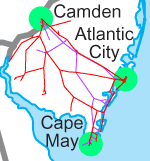
|
| Haddonfield Map |
For a century or more, Haddonfield has had a railroad. Both the Reading and the Pennsylvania railroads ran through Haddonfield on their way from Philadelphia to Atlantic City, and later on, they were combined in the Pennsylvania-Reading Seashore Line. In 1950, the coal-fired steam locomotives still made a grade crossing on Kings Highway and tooted at the outskirts of town. A little awkward, dirty and dangerous, perhaps, but it had to be admitted that regular train service to the Shore was nice, as was regular commuting to Philadelphia. At least once a day, an elegant old train named the Nelly Bly made a round trip to New York, for those who occasionally wanted to take in a show, or do Christmas shopping in style. From the looks of some of the larger Victorian houses in town, there might even have been a few bankers going to Wall Street for important matters. Haddonfield was sleepy, but it had made things very convenient for itself.
And then, around 1970 the price of Haddonfield real estate tripled overnight. The Delaware Port Authority announced its plans for PATCO, a high-speed regular subway-surface line. Now that it is in existence, we have clean comfortable safe trains every seven minutes to the Center of Philadelphia. The express trains used to take eight minutes to Philadelphia, but now we only have locals who take twelve minutes. The main complaint is that there is not quite enough time to read the newspaper.
There's a personal story here. In the articles about the coming high-speed line, I noticed two things: there was to be an elevated overhead track through Haddonfield, and the director of the Port Authority had been a West Point classmate of my uncle. Having spent four years in New York City, my image of an elevated train was highly unfavorable. They were noisy, and the noise created slums all along their path. Not what was wanted in tree-lined Haddonfield, at all. And the General, who among other things was a neighbor up my street a few houses, created a means to change the plans. We held a mass meeting in my house, and among those present was a former regular-Army major, who had been the track engineer for the Illinois Central. He said that he had been through such arguments many times, had usually beaten down the opposition, but as a matter of fact, putting the rail line below grade was perfectly feasible. With that, one thing led to another, and General Casey finally one day was heard to say, "All right, I'll do it. But don't tell Collingswood." Collingswood is two stops closer to Philadelphia, and the main point was that a very popular religious radio station was located a hundred yards from the proposed line. One day, the minister of this station woke up to see an elevated -- an elevated -- being built outside his window. You can imagine all the rest, the radio broadcasts, the protests, the confrontation. But unfortunately, it was too late to make a change of plans.
As an epilogue, it can now be seen that there would have been advantages to the original design. The trains from Philadelphia to Atlantic City run immediately alongside the tracks of the high-speed line for a mile in Haddonfield. If they weren't all squeezed in a ditch, there might have been room for an interchange between the two at Haddonfield. But we don't care, we don't care. When we want to go to the shore, or to New York, we will drive.
Tavistock
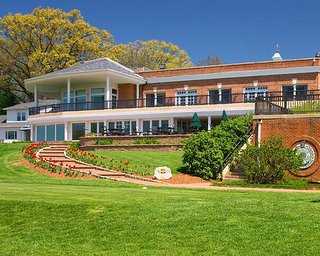
|
| Tavistock country club |
Right next to Haddonfield is another town called Tavistock. It contains four houses, quite large ones, and a perfectly beautiful country club. This geo-political curiosity came about only partly because Haddonfield is dry, no liquor. The present location was created during national Prohibition (of alcohol) when it didn't matter what the local option said. The really devastating local ordinance was a prohibition of playing golf on Sunday. It is probably correct that abolishing liquor is a good way to keep the town looking pristine, so that Haddonfield's continuing dryness had something to do with maintaining real estate values in addition to maintaining sobriety, in the minds of local property owners. This stance was certainly vindicated when a race track was built a mile or so away, and local residents could easily imagine all sorts of high life that might grow up in the shadow of a race course. Haddonfield learned what it thought was the lesson in this, and continues to prohibit alcohol sales (consumption is of course quite another matter) after the repeal of the Volstead Act. So Sam Fulton and the other founding fathers of Tavistock probably knew what they were doing. The existence of Tavistock is the best evidence of the shrewd thought processes in town because in some minds you can't have a country club without liquor. You also can't have much of a golf course without some hills, and hills like Tavistock are in short supply in southern New Jersey. Sam Fulton wanted the place neat and tidy; as Mayor of the four-house town, he passed an ordinance that the birds were required to fly upside down. The legal and political defenses of this oddment seem well planned and emotionally quite prepared to dismember any politician who seeks to make trouble for something odd which isn't entirely accidental.
In 2010, trouble came to Tavistock. Then-Governor Corzine merged the school district of Tavistock with the school district of Haddonfield. The total of four houses in Tavistock collectively only had one child in school, so the burden on Haddonfield wasn't very bad, but the school taxes on Tavistock appeared to be in for a serious upgrade. Tavistock hadn't been founded as a tax haven, but over the years it became so in a minor way. The four houses in Tavistock were remarkably opulent, and of course, they were only paying school taxes to send one or two children to neighboring schools, so they were effectively taxed much less than the residents of the towns who had the schools. Using the old police maxim of cui bono (who has a motive?), one might suspect someone in Haddonfield of stirring up this little class warfare stunt. However, it turns out there are four school districts in New Jersey who are similarly affected, so it seems likely that someone did some research in Trenton. Whether the Target was someone in Tavistock, or someone in Pine Valley, or someone in the other two places, is presently unknown. Sooner or later someone will talk, of course. And since this is the Soprano State, someone else may end up with concrete overshoes.
Laran Bronze
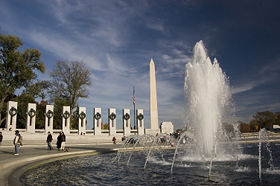
|
| World War II Memorial |
Bronze is the term for alloys of copper, most often mixed with tin, aluminum or whatever in varying proportions. Although the Bronze Age was one of the earliest stages of civilization, most of us would still have a hard time even stating the proper mixture of metals we might need to manufacture some bronze object for some particular purpose. No doubt Alexander the Great and his friends just stumbled on a mixture suitable for swords, helmets, and shields, but nowadays we expect a little more precision than that. So, go visit the engineers and artisans who occupy a whole block of downtown Chester and discover where the engineers take over from the sculptors. For example, the bronzes of the World War II Memorial in Washington were fabricated here, eventually bringing the final bill for the Memorial to $197 million. Whatever Laran may be, it isn't cheap.
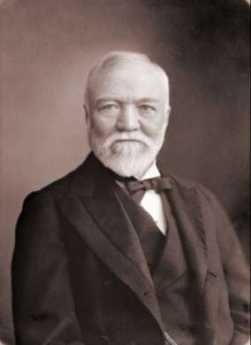
|
| Andrew Carnegie |
Because of the size and weight of monumental bronzes, there is a tendency for bronze fabricators to be chosen in the general neighborhood of the permanent site of the statue. Even so, most large pieces are cast in smaller pieces and welded together at the site. Because that leads to more external struts that have to be trimmed and smoothed out, and more welding, there is a constant struggle to improve the technology to eliminate chop-ups. However, the bigger the piece, the harder it is to support with internal steel struts, so there is a constant process of re-engineering which is considerably under-appreciated. Since Larry Welker the proprietor of this operation went to Carnegie-Mellon, it brings up an analogous situation in steel fabrication. Andy Carnegie is mostly remembered for giving away libraries and mistreating his employees, but in fact, his achievement was an engineering one. His steel mills were four times as productive and efficient as his nearest competitor (Krupp of Germany). That not only made him the richest man in the world, it also made it possible for America to defeat Germany in World War I, and eventually become the dominant superpower.
Since sculptors are in a position to designate the bronze fabricator of their work, it would be wise for the fabricator to be nice to sculptors. However, computers have stuck their nose in this business, as they have in most businesses. A sculptor ordinarily makes a small model whose image is scanned into a computer and then blown up to final size. From this, a positive mold is made, from that a negative mold, and from that, the final positive bronze shell is cast. But once you pass that image through a computer you open up the possibility of synthetic images made through the mechanisms that make animated movies; and maybe eliminate the need for the sculptor entirely. That prospect naturally displeases sculptors, as does the potential for counterfeiting and exporting jobs.
Just about everything about bronze sculpture revolves around its massive weight. That's why bronze statues are typically hollow but carried too far, the statue can't support its own weight and must have internal steel struts. The internal struts are mainly stainless steel, often encased in the plastic sheathing. The molds which make these eggshells are generally made of ceramic, which is melted sand. The process starts with wax coatings, often a quarter-inch thick dipped in fine sand, then a layer of coarse sand finally baked into ceramic. That's the negative mold; the positive mold from which it is made starts with wax, covered by latex, covered by plaster of Paris. Since a lot of steps don't come out perfectly, they have to be repeated. All in all, it becomes convincing that spending $197 million for a war memorial is entirely legitimate, because we haven't even described the costs for the artist at one end of the process, and the appalling transportation issues at the final step.
Although the WWII Memorial isn't even in Philadelphia, it's surely worth a trip to Washington to see what Philadelphia can do. While you are there, look for the "Easter Eggs". That's the term for humorous images hidden by the artist within the serious larger object. This too is a tradition going back to ancient times; in the case of the War Memorial, the artist hid images of at least one soldier "goofing off" in each freeze. Perhaps even that could be done by computer, but it's harder.
WWW.Philadelphia-Reflections.com/blog/1291.htm
Port of Philadelphia
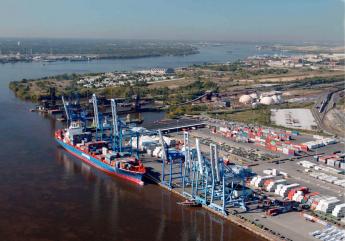
|
| Ports of Philadelphia |
When federal appropriations are doled out, it is a great advantage for the Port of Philadelphia to appeal to six U.S. Senators. However, the overlapping control of port operations can come close to paralysis. In short, we may have less chance of agreement on what we want -- but a greater chance of getting it. Right now, the ports of the world are struggling to adjust to revolutions of containerized cargo and gigantic oil tankers, plus political pressure from concern about the environment.
Some of the main arenas of our gladiator fights are as follows:
DRPA: The Delaware River Port Authority operates several large bridges, the PATCO high-speed subway line, and the cruise terminal, all leading to control of potentially large sources of revenue. The 1992 Congress expanded its charter to include the economic development of the port region.
SJPC: The South Jersey Port Corporation owns two marine terminals in Camden, and is planning a third in Paulsboro.
DSPC: The Delaware State Port Corporation operates the Port of Wilmington, DE.
PRPA: The Philadelphia Regional Port Authority has little to do with city politics, but is an arm of the state government of Pennsylvania, operating 7 marine cargo facilities, and planning more.
In addition, every county, city, and town along the riverbank has some degree of authority. Every business and union involved in regional or international trade is desperate to protect its interest in the politics of port regulation. Lately, the Homeland Security Agency has taken a large role. Scientists, engineers, fishermen, oil refinery operators, economists, and others abound. The news media convey their own opinions and the opinions of others. Opinions abound because most issues about ports are important.
In addition to the traditional cargoes of coal, petroleum, iron ore and forest products, which are mostly declining in importance, the rising cargoes include meat, cocoa beans, and South American fruit. General, or casual, cargo tends to be more valuable than bulk cargo, but greatly complicates the Homeland Security risks. The ratio of imports to exports is important because it is expensive to have a ship return empty. Shippers will, therefore, favor a port where there are expectations of return cargo. Oil tankers are particularly likely to return empty since their ballast is mostly river water; but, who knows, perhaps global warming will make dirty river water seem valuable to some tropical oil producer. A quirky problem is that most of the crude oil entering East Coast ports are currently coming from Nigeria, a notoriously corrupt nation. This has led to a thriving business of car-jacking in the Philadelphia suburbs, with the stolen cars promptly packed in empty containers returning to Africa.
Of the 360 major American ports, the Delaware River ranks second in total tonnage shipped, and eighth in the dollar value of the cargo. Every year, 2600 ships call into our port, which claims to employ 75,000 people. According to Bill McLaughlin of the PRPA, the future of the port will depend on the settlement of three major disputes:
1. Deepening the Channel. The historical natural level of the river is 17 feet, artificially deepened to 40 feet up to the level of the Walt Whitman Bridge. It sludges up by two or three feet every few years, so dredging is a continuous issue. The enlargement of tankers and container ships has led to a need to deepen the channel to 45 feet. It is true that the Wissahickon schist pokes up at Marcus Hook and will have to be blasted out, but mainly the issue is dredging up the gunk on the river bottom, and hauling it away somewhere. In Delaware Bay below Pea Patch Island, the bottom is sandy and hence valuable. The State of Delaware has plans for riverfront development, and would actually like to have the 8 million tons of sand, so no problem. The 7 million tons of clay and silt which must be dredged out of the upper Delaware River channel for a 45-foot depth is more of a problem, but users can be found for most of it. Or so the Pennsylvania representatives maintain; the New Jersey representatives led by Congressman Rob Andrews say it would be an environmental disaster to dump a thimbleful on New Jersey. Feelings get pretty hot in these things. The Haddonfield representative is portrayed as selling out his district in order to further his own state-wide aspirations, acting on the orders of North Jersey politicians who dominate New Jersey politics, who want to lessen competition with the Port of New York, which also shares a border with New Jersey. Feelings are not soothed to see the Port of New York deepening its channel to fifty feet while resisting forty-five in the Delaware port.
The document currently at the center of this interstate dispute is called PCA, the Project Cooperation Agreement. New Jersey won't agree to sign the proposal, which contains clauses to remove the DRPA from authority and replace it with PRPA(essentially transferring control and revenues from Philadelphia to the State of Pennsylvania) as the "non-federal sponsor". PRPA would then enter into a contract with the Army Corps of Engineers to get the work done.The price, probably low-balled, is $219 million, to be compared with the Port of New York's dredging price (probably high-balled) of $50 billion. There are, of course, a great many features of this political negotiation which are unlikely to appear in print.
2. Southport. The grand plan for the Philadelphia Port is to center on an intermodal complex of piers, railroads, and highways which would extend as a continuous terminal from the Walt Whitman Bridge to the old Naval Yard. No doubt this idea is linked to the round-the-world concept of Philadelphia as a way station from India to Vancouver, overcoming the empty return cargo problem by never looking back. Good luck.
3. Monetizing the Port. Like the turnpikes, ports could be sold to private investors. Of course, that could extend to selling the property to foreign investors, triggering the nationalist reaction readily observed when port management was once offered to Abu Dahbi. It could well give a new meaning to the expression, being sold down the river, but who knows maybe it's a good idea. When you criticize motives it never bothers real political pros, because it's simple to say you don't have such motives, and who knows. But the people seriously involved in government finances say they most fear that the do-gooders will be allowed to sell or lease publicly-owned facilities to improve the financial balance sheet. And then the pros will just take the money and use it to pay interest on more borrowing.
WWW.Philadelphia-Reflections.com/blog/1337.htm
The Corinthos Disaster
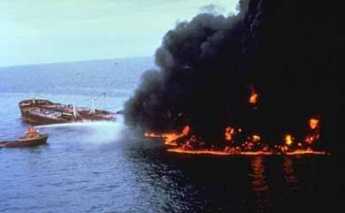
|
| Oil Tanker on Fire |
Fire, huge fire. The Corinthos disaster of January 30, 1975, was the biggest fire in Philadelphia history, and one hopes the biggest forevermore. Its immensity has possibly lessened attention for some associated issues which are nevertheless quite important, too. Like the issue of punitive damages in a lawsuit, or the need to balance environmental damage with a national need for energy independence. And the changing ways that law firms charge their clients. We hope the relatives of the victims will not be offended if the tragedy is used to illustrate these other important issues.
On that cold winter day, two big tanker ships were tied up alongside the opposite banks of the Delaware River at Marcus Hook. The Corinthos was a 754-foot tanker with a capacity of 400,000 barrels of crude oil, tied up on the Pennsylvania side at the British Petroleum dock with perhaps 300,000 barrels still in its tanks at the time of the disaster. At the same time, the 660-foot tanker Edgar M. Queen
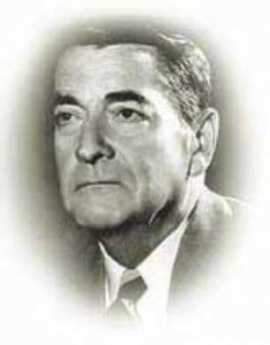
|
| Edgar M. Queeny |
with roughly 250,000 barrels of specialty chemicals in its hold, let go its moorings to the Monsanto Chemical dock directly across the river in New Jersey, intending to turn around and head upstream to discharge the rest of its cargo at the Mantua Creek Terminal near Paulsboro. Curiously, a tanker is more likely to explode when it is half empty because there is more opportunity for mixing oxygen with the combustible liquid sloshing around. A tug stood by to assist the turn, but the master of the Queeny felt there was ample room to make the turn under her own power. With no one paying particular attention to this routine maneuver, the Queeny seemed (to only casual observers) to head directly across the river, ramming straight into the side of the Corinthos. Actually, the Queeny had engaged in a number of backing and filling maneuvers, and the sailors aboard were appalled that it seemed to lack enough backing power to stop its headlong lunge at the Corinthos. There was an almost immediate explosion on the Corinthos, and luckily the Queeny broke free with only its bow badly damaged. Otherwise, the fire might have been twice as large as it proved to be with only the Corinthos burning. The explosion and fire killed twenty-five sailors and dockworkers, burned for days, devastated the neighborhood and occupied the efforts of three dozen fire companies. A graphic account of the fire and fire fighting was written by none other than Curt Weldon who was later to become Congressman from the district, but was then a volunteer fireman active in the Corinthos tragedy.
There were surprising water shortages in this fire on the river because the falling tides would take the water's edge too far away from the suction devices for the fire hoses on the shore. The tide would also rise above a gash in the side of the burning ship, floating water in and then oil up to the point where it would flow out of the ship onto the surface of the river. Oil floated two miles upstream from the burning ship and ignited a U.S. Navy destroyer which was tied up at that point. Observers in airplanes estimated the oil spill was eventually fifty miles long. All of these factors played a role in the decision whether to try to put the fire out at the dock or let it burn out; experts continue to argue which would have been better. There were always dangers the burning ship would break loose and float in unexpected directions, that the oil slick would ignite for its full length, and that storage tanks on shore would be ignited. The initial explosion had blown huge pieces of iron half a mile away, and the ground near the ship was littered with charred, dismembered pieces of flesh from the victims.
, Of course, there was a big lawsuit. When a ship is tied up at a dock it certainly feels aggrieved when another ship crosses a river and rams it. The time-honored principle of admiralty law holds that the owner of an offending ship is not liable for damages greater than the salvage value of its own hulk, which in this case might have been about $3 million. The underlying assumption is that the owner has no way of knowing what is going on thousands of miles away, no control over it, no power to respond in a useful way. Enter Richard Palmer, counsel for the Corinthos. Palmer was aware that the National Transportation Safety Board collects information about ship maintenance inspections in order to share useful information for the benefit of everyone. His inquiry revealed that the inspections of the Queeny for four years before the crash had repeatedly demonstrated that the stern engine had a damaged turbine, and was only able to drive the ship at 50% of its rated power. Why this turbine had not been repaired was now irrelevant; the owners of the ship did have relevant information and had failed to act in a timely safe fashion. The limitation of liability to the salvage value of the hulk now no longer applied if the negligence was judged relevant. The defendants, the owners of the Queeny, decided to settle. While the size of the settlement is a secret of the court, it is fair to guess that it approached the full value of the suit, which was $11 million. Mr. Palmer, by using his experience to surmise that maintenance records might be available at the Transportation Agency, and recognizing that the awareness of the owner might switch the basis for the compensation award from hulk value (of the defendant's ship) to the extent of the damage (to the plaintiff's ship), probably tripled the damage settlement.
Reflections on the extraordinary benefit to the client from a comparatively short period of work by the lawyer leads to a discussion about the proper basis for lawyers fees. Senior lawyers feel that the computer has revolutionized lawyer billing practices, and not for the better. Because it is now possible to produce itemized billing which summarizes conversations of less than a minute in duration, services for the settlement of estates can be many pages long, mostly for rather routine business. Matrimonial lawyers are entitled to charge for hours of listening to inconsequential recriminations; lawyers can bill for hours of time spent reading documents into a recording machine, or sitting wordlessly at depositions. Since the time expended can now be flawlessly measured and recorded on computers, there is little room for a client to remonstrate about their fairness. Discomfort about this system underlies much sympathy for billing for contingent fees, where the lawyer is gambling all of his expenses and effort against a generous proportion of the award if he wins the case, nothing at all if he loses. This latter system, customary in slip and fall cases and justified as permitting the poor client to have proper representation, undoubtedly promotes questionable class action suits and often leads to accepting personal liability suits which should be rejected for lack of merit. The thinking underlying personal injury firms is widely said to be: most insurance companies will settle for modest awards in cases without merit because the defense costs would be no less than that amount, and occasionally a personal liability case gets lucky and extracts a huge award.
Listen to one old-time lawyer describe how legal billing used to be. After the case was over, the lawyer and the client sat down to a discussion of what was involved in the legal work, and what it accomplished for the client. A winning case has more evident value than a losing one, provided the lawyer can effectively describe the professional skills that helped bring it about. The whole discussion is aimed at having both parties leave the discussion satisfied. To the extent that both parties actually are satisfied with the value of the services, the esteem and reputation of the legal profession are enhanced. And the lawyer is a happy and contented member of a grateful community. If he can occasionally claim a staggering fee for a brief but brilliant performance, as in the case of the explosive fire on the Corinthos -- well, more power to him.
It does not take much familiarity with oil refineries to make you realize that cargoes of crude oil are a very dangerous business. We are accustomed to hearing jeers at those who protest, "Not in my backyard", and we deplore those who would jeopardize our national security to protect a few fish and trees in the neighborhood of potential oil spills. Since we do have to import oil and we do therefore have to jeopardize a few selected neighborhoods to accomplish this vital service, the opponents are sadly destined to lose their protests. But that doesn't mean their concerns are trivial. The shipping and refining of oil are dangerous. We just have to live with it and be ready to pay for its associated costs.
New Jersey Ponders a Rising Sea Level
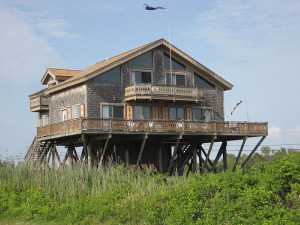
|
| Future House Styles? |
A certain gentleman in a professional position to dominate conversations about rising sea levels, is afraid of being sued and requests his name be withheld from the following. Let's just call it hearsay, suitable only for conversational banter.
If the icecap now sitting atop Greenland should melt, it can rather easily be calculated that sea level would rise to the point where the Delaware River would be 83 feet deep. The Army Corps of Engineers would then probably have more urgent matters to attend to, but at least they would no longer have to cope with deepening the channel to 40 feet. If the Antarctic ice cap should then melt on top of it, the sea level would rise an additional 220 feet, resulting in a Delaware River 300 feet deep. There might be some dry real estate on top of Blue Mountain, but not much else on the Atlantic seaboard would be dry, so there would likely be the additional problem of keeping other people from climbing up to sit in your perch. Perhaps the Hawks would bring you something to eat.
A more immediate issue relates to the barrier islands. It is thought the crumbling of mountains into the sea accounts for the sandy beaches of the Atlantic and Gulf coasts; the more recent mountains along the West coast have not progressed to the point of piling up enough sand to start the process. The cycle of barrier islands is as follows.
Barrier islands, if left undisturbed, will gradually migrate toward the land mass behind them, filling up the intervening bay, and eventually adding to the mainland. But that's not the end of the cycle, because the continuous wave and tidal action will generate a new barrier island further out to sea. When the new island reaches a critical equilibrium with the waves and storms, it begins the cycle of deterioration all over again. Presumably, the sandy lowlands of southern New Jersey, the Delmarva Peninsula, and most of Florida are the result of many cycles of barrier islands adding themselves to the mainland. Presumably, the process will run out of sand someday, but not soon enough to worry about.
When affluent people build showplaces on the barrier islands, a great deal of concrete is laid on the island surface for roadways and parking lots, as well as jetties and other desperate efforts to prevent erosion from destroying the beaches, beachfront property, and real estate values. This process is much more active and rapid than most sunbathers seem to imagine. There are channel markers and monuments of the 18th century that are a mile or more out to sea in the 21st century. Almost a mile of beachfront has disappeared at Cape May and Cape Henlopen in Delaware. Lots of other real estate has been swallowed, but records of historical markers at the mouth of the bay have been more diligently maintained. The residents demand that sand be dredged and dumped on their beaches to keep even with the destructive forces at work. All of this ultimately useless resistance to Nature costs a great deal of money. Those who observe the contest between the protests of King Canute and the resistance of other New Jersey taxpayers to rising taxes estimate that around 2040 the cost of interrupting the barrier island cycle will become so burdensome that taxpayers will successfully put a stop to resisting natural beach erosion. The political uproar will surely be horrendous, so there is a good reason for oceanographers to avoid going public with these inconvenient truths. And all of this doomsday talk, by the way, ignores the issue of global warming, which will surely make it all the worse.
Philadelphia City Controller

|
| Alan Butkovitz |
The Right Angle club was pleased to hear the City Controller, Alan Butkovitz, give us an insider's view of the municipal finances, but was a little startled to hear how badly the national banking crisis has affected our city. While of course the city does a lot of things, its present finances can be summarized as mainly consisting of two things: the pension system and the management of police/fire/corrections.
Mayors of this city for several decades have been following the national pattern of government to transfer its deficits to the pension funds of the employees. That has the effect of shifting the cost of present operations into the far future and avoiding present confrontations by promising even more generous pension benefits in the future. Over time, the future gets closer and closer; to a large degree, it is right now. Pension funds are largely independent organizations, supposedly receiving current contributions to be invested for future distribution. That requires an assumption about how much investment growth will be achieved in the meantime, now set by the Philadelphia Board of Pensions at 9%. That's not impossible to achieve in some medium-term intervals. But it's optimistic, even inconceivable, for long-haul investing; over periods of thirty or more years, most experts say that 4% is about all anyone gets. More to the point, 9% is particularly unachievable right now, in the present crash of national financial markets. That's bad enough, but repeated shortfalls in contributions to the fund have left it funded at 53% of the calculated requirement to pay the pensions of the future, even using the unrealistic 9% return assumption. A few years ago, Mayor Rendell worried about the underfunding and brought it up to 70% with a billion-dollar bond issue. Unfortunately, the crash in the markets has brought it right back down to 53% again. So, it's fair to say the pension fund is a couple of billion dollars short, even if you accept a 9% income accumulation -- which you probably can't, but at least it brings the pension fund to 70% funding in forty years. Call it four billion dollars short, just to be conservative, since it is presently admitted to being two billion. That isn't Mayor Nutter's fault, but it's sure his problem; and if it gets worse, it will be seen as his fault.
The other expense item of note includes 42% of the budget in the police, fire and prisons systems (education is handled separately through the school board). If you fired all those people, or they quit, we wouldn't have a city, we would have a jungle. But the Controller describes all three as terribly mismanaged, with the local police stations in a deplorable state of disrepair and degradation, bathrooms you wouldn't think of using, and so on. The fire department has only a minor number of fires to fight, perhaps four or five hundred a year, but it includes the emergency rescue services which respond to a couple hundred thousand calls a year. The rescue people report to the firemen, and there is social friction between the two, working to the disadvantage of rescue. It costs about $500 to respond to a call, and it isn't entirely satisfactory to send a fire truck to help someone with a heart attack. The Controller had a number of horror stories about administrative mismanagement in this area. As far as prisons go, everybody knows prisons are bad places, and ours are no exception. Confrontation with the unions is definitely in the future for the Mayor, and the city is going to be in pretty bad shape if he doesn't win some arguments.
That's the expense side of the municipal budget; the revenue side is equally gloomy. The offhand comment was that real estate taxes could double without bringing the pension system under control for twenty years. If our taxes are significantly higher than neighboring cities, or even just the same as in cities with superior uniformed services, it will be hard to attract and hold business taxpayers, causing municipal finance to spiral downward. Along the course of this patter-song, it isn't exactly reassuring to learn that it now takes the City 21 days to process a check and that absenteeism in some departments runs to 20%. We've heard a lot of denunciation of Mayors Giuliani and Bloomberg in New York, but their absenteeism runs 3% because investigators are sent to the house of an absentee, who is subject to court martial if he isn't home.
Somewhere in this nightmare lurks the hidden migration of the unionized workers. Starting with Mayor Rizzo or even earlier, the uniformed services were the main political support of the Democrat political machine. Quietly, they have moved out to the suburbs where the schools are better and the taxes are lower, and it is now said that 70% of union workers live (and vote) outside the city limits. The unions talk tough, bluffing through the uncertainty when their members can no longer provide the votes to be so fearsome. To some degree, their weakening political power is augmented by using their pension funds to provide construction loans for new commercial real estate. Some of that political clout is used up by the need to get zoning variances and tax abatements for the projects. A lot of these power shifts are hard to assess from the outside, but a trend is clear.
The controller didn't mention it, but the city is not only a pension investor in bonds but also an issue. Interest rates are about as low as they can get while the Federal funds rate is nearly zero, so there is only one direction they can go in the future -- sooner or later they will go up. By the iron law of bond financing, the value of the underlying principle will then go down. That could provide an opportunity to buy them back at lower prices, or it could break the city's financial back financing higher interest payments. However, for the pension fund side of things, exactly the opposite is true. Maybe Hizzoner can tap-dance around these dangers and opportunities, but most mayors would have trouble pronouncing the words.
It's part of the job description for the controller to be a pessimist. But the most you can make of this mournful dirge is to hope he is completely wrong.
Not a Single Red Knot
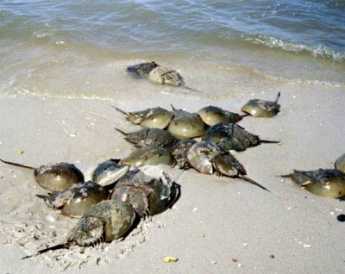
|
| Horseshoe Crabs |
A full moon brings high tide, which for centuries has brought vast numbers of horseshoe crabs to the banks of the Delaware River, toward the end of May. Marine biologists tell us these ugly-looking beasts have evolved very little for thousands of years.
Horseshoe crabs transport oxygen through their blood as a blue copper compound instead of that iron-containing hemoglobin the rest of us use. That's red, of course. Somewhere in the evolutionary path, these ancient animals also neglected to develop an immune system, but defend themselves against bacteria by precipitating sediment when they encounter endotoxin. By luck, this reaction takes place even though the bacteria are dead, so it is routinely employed as a way of detecting and eliminating endotoxin in intravenous fluids, which would otherwise go undetected by failing to grow the original bacteria in conventional culture media. Unfortunately, those of us who have never experienced a temperature spike to 106 degrees from an intravenous infusion of "sterile" water is more or less indifferent to the contribution of the Delaware crabs to our well-being. As well as being sadly indifferent to the unique nature of their nerve cells, in long single neurons, which make a number of important experiments possible.
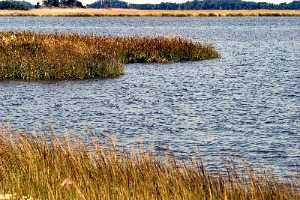
|
| Bombay Hook |
The horseshoe crab offers still other attractions. When they come ashore to lay eggs (at a full moon, or high tide, in May), they lay incredibly large quantities of them, attracting astonishing swarms of birds, which can be seen gliding a few feet above the water surface in groups of hundreds or even thousands. The Red Knot sandpiper is certainly not the only egg-eater at Bombay Hook, but there are some unique features of that bird to be mentioned in a minute. A lot of people object to being attacked by monster swarms of mosquitoes in the summer, but screens and air-conditioning have encouraged a large number of rather prosperous houses to be built along the shore, particularly where there are sandy beaches. In fact, it is so crowded the Fish and Wild Life Service has placed street lights at such public places, with a narrow driveway to lead you to the beach. If you don't know how to recognize such amenities, well, too bad for outsiders.
Although there are plenty of naturalists and bird-watchers who come in the early spring, most of the houses along "Slaughter Beach" seem to belong to fishermen and duck hunters, the two outdoor sports with most popularity. Different migrations of different food-producers bring different prey for the sportsmen, but somehow the most up-scale members of this fraternity tend to go there in May, looking for Red Knots. A Red Knot is a form of sandpiper, with a red head and breast. The birds are born in the Arctic tundra, eating vast amounts of mosquito eggs and larvae, migrating south in the fall. They winter over in Tierra del Fuego at the opposite end of the earth and then migrate north to Bombay Hook on Delaware. For these long migrations, they must eat voraciously when they do eat and somehow have learned to look for the horseshoe crab eggs at just the right time, presumably following cycles of the moon for timing. Residents of the area for centuries have remarked on the timing of the birds and the tides and the crabs. Unfortunately, the two-continent migration was only recognized fairly recently, and when the supply seemed endless, the crabs were scooped up and used for fertilizer until their supply began to dwindle; both Delaware and New Jersey now have protective legislation, and Virginia is being verbally excoriated by bird watchers, to do the same. The crabs have started to come back, but the Red Knots are slower to respond, and now the threat is Sushi. Another ecological damage has reduced the supply of crabs in the Pacific, so the crab fishermen have migrated to the Atlantic to catch the crabs as bait for conch and other ingredients of Sushi. Once again, the abundance of crabs has declined, although to a much smaller degree than the Red Knots. This year, on the very best day of the year for this sort of thing, with dozens of out-of-state license plates wandering aimlessly up and down thirty miles of shoreline, the shouted greetings among serious bird watchers returned the sad news, "No Red Knots today. Try the beach." It was generally agreed there was a bit too much wind for good Red Knot sighting, and that oil spills in the Gulf of Mexico were to be suspected, and that perhaps tomorrow would be a better day. But judging by the very expensive optical equipment these people were carrying around, these were serious birders, indeed. If they couldn't find Red Knots, the rest of us might as well give up.
The most plausible theory for the latest decline centers around the old-timer birds. When the first-timers start their northward migrations, they are guided by the old-timers who have made the trip at least once before. If something injures the flock, it may be a few years before the supply of old-timers revives enough to supply the first-timers with guides. That's just a theory, of course, but currently the most popular one. Just what it would take to eliminate the Red Knot migration completely, may now be close to being tested. Just on principle alone, it does seem a pity to eliminate a phenomenon which took thousands of years to develop.
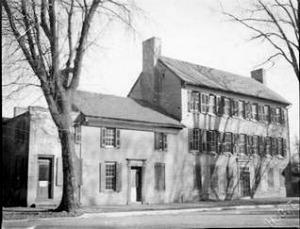
|
| Benjamin Chew's Whitehall |
When you finally give up on Red Knots, you might as well wander around this enormous wildlife sanctuary. A few miles up the road is the former location of Whitehall, the plantation house of Benjamin Chew, lawyer for the family of William Penn, and owner of the stone fortress on Germantown Avenue in Philadelphia that thwarted George Washington's attempt to stall and starve the British before they could join up with their ships in the harbor below Fort Mifflin. The original buildings on the plantation have disappeared, but the spongy plantation trails have been replaced by elevated gravel roads. So it is possible to roll up the windows of your car in mosquito season, turn on the air conditioning, and cruise around the spectacularly beautiful ponds and inlets. Further south is the plantation of Caesar Rodney, who rode to Philadelphia in the rain to cast the deciding vote for the Declaration of Independence. And further south of that is the plantation of John Dickinson, who made Rodney's ride necessary by refusing to sign the Declaration, on the grounds that the colonies showed insufficient unity, in his eyes, to be able to win a war with England. And anyway, the argument was largely economic, hence more likely to be won by economic means than military ones.
To the west of these historic plantations are some pretty impressive farms, new style. The houses give them away since no farmer will spend a cent on his house if he can profitably expand his farm; these houses belong in glossy magazines. The silos are grouped in clusters of ten or twelve, the irrigation sprinklers are a quarter-mile long, attachable to what resembles a fire hydrant in the center of the field. There are over a hundred sheds on some farms, filled with chickens fattening up. And do you know what? You can drive for miles without seeing a single chicken.
Eventually, the road leads to the Dover Air Force Base, very large indeed. No planes are in evidence, as is true on most days. But one day in 1962 Mr. Kennedy was talking to Mr. Castro, and overhead at Dover you could see dozens, maybe hundreds, of eight-engine bombers. Just circling, circling, waiting for orders to go lay an egg on the Kremlin. It wasn't clear to onlookers at the time, just what this was all about. But the idea can now be entertained that perhaps Red Knots weren't the only species flirting with extinction.
| Posted by: [none] | May 3, 2012 3:44 PM |
| Posted by: Jackie Vinyard | Aug 1, 2008 10:46 AM |
| Posted by: Peyton | Nov 12, 2007 7:27 PM |
38 Blogs
Day One: Camden to Cape May
 Pine Barrens occupy the center of South Jersey. Settlements for three centuries have clustered along both banks of the Delaware Bay, like beads on two strings. On the Jersey side of the bay runs the King's Highway from Haddonfield to Salem. From there to Cape May, follow the Del-Sea Drive.
Pine Barrens occupy the center of South Jersey. Settlements for three centuries have clustered along both banks of the Delaware Bay, like beads on two strings. On the Jersey side of the bay runs the King's Highway from Haddonfield to Salem. From there to Cape May, follow the Del-Sea Drive.
Day Two: Rehoboth to Kennett Square
 The southwestern shore of Delaware Bay was an isolated swampy world until a couple of decades ago. It now seems to hurtle toward a resemblance to Luxembourg or Liechtenstein. Any way you look at it, the State of Delaware is very charming.
The southwestern shore of Delaware Bay was an isolated swampy world until a couple of decades ago. It now seems to hurtle toward a resemblance to Luxembourg or Liechtenstein. Any way you look at it, the State of Delaware is very charming.
Delaware Bay Before the White Man Came
 This was the last major place on the East Coast to be settled because it was a swampy snaggy pond, full of fish and birds. And soon, pirates.
This was the last major place on the East Coast to be settled because it was a swampy snaggy pond, full of fish and birds. And soon, pirates.
Tony Junker: Tunnell's Boys
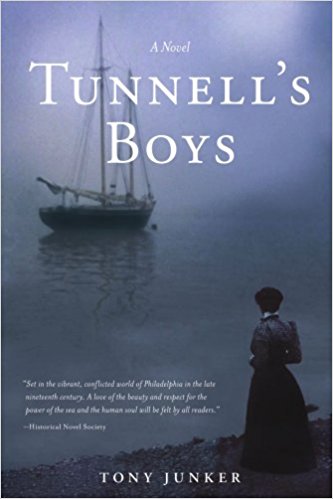 Pilots once had to race from the mouth of Delaware Bay to meet incoming ships. First one there got the job.
Pilots once had to race from the mouth of Delaware Bay to meet incoming ships. First one there got the job.
The Philadelphia Bay (1)
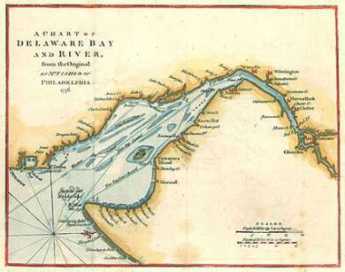 In geological times, New Jersey and Delaware were barrier islands of the Atlantic, and lower Delaware Bay was the inlet between them. Then, we silted up and formed land bridges, leaving a twisting extension of a river which originally ended at Trenton. Upper Delaware Bay is Philadelphia Bay.
In geological times, New Jersey and Delaware were barrier islands of the Atlantic, and lower Delaware Bay was the inlet between them. Then, we silted up and formed land bridges, leaving a twisting extension of a river which originally ended at Trenton. Upper Delaware Bay is Philadelphia Bay.
Jersey
 Understanding New Jersey means understanding its unusual geography, and its Quaker origin as one of the three colonies owned by William Penn.
Understanding New Jersey means understanding its unusual geography, and its Quaker origin as one of the three colonies owned by William Penn.
Remember This Date: May 18
Lower Delaware Bay is teeming with successive migrations of seafood. May 18 is a pivotal day, give or take a few days.
Where Do Shad Go, When They Aren't Around Here?
 The Bay of Fundy.
The Bay of Fundy.
Founding Fish

Georgetown Oyster Eat: Separate but Equal
 The Delaware Bay once teemed with Oysters, and local firehouses were supported by annual oyster festivals. A few places bravely keep up the tradition.
The Delaware Bay once teemed with Oysters, and local firehouses were supported by annual oyster festivals. A few places bravely keep up the tradition.
Georgetown Returns Day
 Glimpse what American democracy was supposed to be in the little Delaware village of Georgetown, even after nearly three centuries have gone by. Two days after the election, the victorious and the defeated candidates still appear for announced election results, ride around the courthouse in a carriage together, and actually bury a hatchet.
Glimpse what American democracy was supposed to be in the little Delaware village of Georgetown, even after nearly three centuries have gone by. Two days after the election, the victorious and the defeated candidates still appear for announced election results, ride around the courthouse in a carriage together, and actually bury a hatchet.
Delaware's Court of Chancery
 Georgetown, Delaware is a pretty small town, but it's where the major corporations of the nation plead their case.
Georgetown, Delaware is a pretty small town, but it's where the major corporations of the nation plead their case.
John Dickinson, Quaker Hamlet
 John Dickinson was the most respected lawyer and politician of his time. He had a lot to do with writing the Declaration of Independence but refused to sign it.
John Dickinson was the most respected lawyer and politician of his time. He had a lot to do with writing the Declaration of Independence but refused to sign it.
A Pennsylvania Farmer in Delaware
 John Dickinson achieved national fame in 1773 by publishing twelve letters written earlier denouncing the Townshend Acts. They were published anonymously as Letters From a Pennsylvania Farmer. His farm, curiously, was in Delaware.
John Dickinson achieved national fame in 1773 by publishing twelve letters written earlier denouncing the Townshend Acts. They were published anonymously as Letters From a Pennsylvania Farmer. His farm, curiously, was in Delaware.
Delaware Declares Independence ... From Pennsylvania
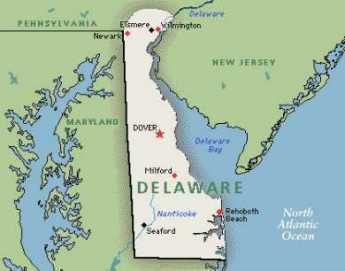 To the despair of its school teachers, few Delaware citizens know or care how Delaware split off from Pennsylvania when William Penn owned them both. In fact, he also owned New Jersey.
To the despair of its school teachers, few Delaware citizens know or care how Delaware split off from Pennsylvania when William Penn owned them both. In fact, he also owned New Jersey.
Pirate Lair
 Did Blackbeard use the Delaware marshes as a hideout?
Did Blackbeard use the Delaware marshes as a hideout?
Odessa, Delaware
 Rodney Sharp fixed up his old home town, and it's an architectural jewel worth visiting. Christmas is the best time.
Rodney Sharp fixed up his old home town, and it's an architectural jewel worth visiting. Christmas is the best time.
Pea Patch Island
 A string of three forts at the level of the Delaware-Chesapeake Canal once guarded the approaches to Philadelphia but were never needed. After the Battle of Gettysburg, Fort Delaware on Pea Patch Island served as a deplorable prison camp for Confederate prisoners; it's now a tourist stop.
A string of three forts at the level of the Delaware-Chesapeake Canal once guarded the approaches to Philadelphia but were never needed. After the Battle of Gettysburg, Fort Delaware on Pea Patch Island served as a deplorable prison camp for Confederate prisoners; it's now a tourist stop.
Elizabethan Accents in Philadelphia
 In the birthplace of American independence, there's still a lot of Olde English buried in the speech patterns.
In the birthplace of American independence, there's still a lot of Olde English buried in the speech patterns.
New Castle, Delaware
 A short history of a historically significant town, now off the beaten path.
A short history of a historically significant town, now off the beaten path.
Caesar Rodney Rides Through the Rain
 When it looked as though Delaware was wavering on the Declaration of Independence, Caesar Rodney was summoned to ride through the rain to cast a deciding vote, in spite of advanced cancer of his jaw.
When it looked as though Delaware was wavering on the Declaration of Independence, Caesar Rodney was summoned to ride through the rain to cast a deciding vote, in spite of advanced cancer of his jaw.
Pennyslvania's Boundary: David Rittenhouse, Hero, Lord Baltimore, Villain
 Because a local genius invented and perfected surveying instruments, America is one of the few nations in the world with straight-line boundaries.
Because a local genius invented and perfected surveying instruments, America is one of the few nations in the world with straight-line boundaries.
Brandywine Museum
 The Wyeths, one of the great artistic families of America, display their work in the Brandywine Museum, which is itself a work of art.
The Wyeths, one of the great artistic families of America, display their work in the Brandywine Museum, which is itself a work of art.
Greenwich, Where?
 A charming little colonial village in the Pine Woods of New Jersey has a long history, few visitors, and nothing reconstructed. It's the real thing.
A charming little colonial village in the Pine Woods of New Jersey has a long history, few visitors, and nothing reconstructed. It's the real thing.
The Final Capture of Philadelphia (6)

The Proprietorships of William Penn
 William Penn owned Pennsylvania, New Jersey, and Delaware; as the proprietor, he was the largest private American landowner, ever. Although the Revolutionary War mostly ended that, one of his proprietorships still owns all unclaimed land in southern New Jersey.
William Penn owned Pennsylvania, New Jersey, and Delaware; as the proprietor, he was the largest private American landowner, ever. Although the Revolutionary War mostly ended that, one of his proprietorships still owns all unclaimed land in southern New Jersey.
Riverline: Camden and Amboy Revival
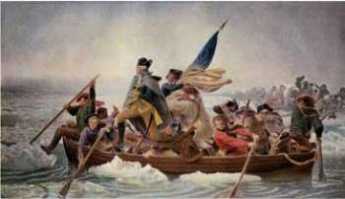 One of the oldest rail lines in America is coming back to life, and maybe bringing the towns along with it back to life, too.
One of the oldest rail lines in America is coming back to life, and maybe bringing the towns along with it back to life, too.
Battleship New Jersey: Home is the Sailor
 The battleship New Jersey, mightiest dreadnought in our history, now rests in Camden. At one time, it could have blown up Valley Forge without moving from that position.
The battleship New Jersey, mightiest dreadnought in our history, now rests in Camden. At one time, it could have blown up Valley Forge without moving from that position.
The Victor Talking Machine Company
 Caruso sang for this record company over in Camden, whose other recordings made the fortunes of the Philadelphia Orchestra. The bitter survivors of RCA Victor believe the Sarnoff family wrecked the company .
Caruso sang for this record company over in Camden, whose other recordings made the fortunes of the Philadelphia Orchestra. The bitter survivors of RCA Victor believe the Sarnoff family wrecked the company .
The Origins of Haddonfield
 Haddonfield was founded by a 19-year-old Quaker girl in 1701 when it was still a fairly dangerous place to walk around. She has over 140 direct descendants, and forty of them still live in the town. Some famous scenes from the Revolutionary War took place here.
Haddonfield was founded by a 19-year-old Quaker girl in 1701 when it was still a fairly dangerous place to walk around. She has over 140 direct descendants, and forty of them still live in the town. Some famous scenes from the Revolutionary War took place here.
Railroading Haddonfield
 Steam engines puffed through the center of Haddonfield, not so long ago.
Steam engines puffed through the center of Haddonfield, not so long ago.
Tavistock
 A town with only four houses shows you what can be done when you really need to play golf.
A town with only four houses shows you what can be done when you really need to play golf.
Laran Bronze
 Occupying an entire block of industrial Chester, a little industry of mechanized artist-engineers make most of the big bronze statues in Eastern America.
Occupying an entire block of industrial Chester, a little industry of mechanized artist-engineers make most of the big bronze statues in Eastern America.
Port of Philadelphia
 The Port of Philadelphia has access to six U.S. Senators from its surrounding states, but the price to be paid is endless political wrangling.
The Port of Philadelphia has access to six U.S. Senators from its surrounding states, but the price to be paid is endless political wrangling.
The Corinthos Disaster
 We hope the 1975 Corinthos disaster proves to be the worst fire in Philadelphia history; it's hard to imagine a bigger one.
We hope the 1975 Corinthos disaster proves to be the worst fire in Philadelphia history; it's hard to imagine a bigger one.
New Jersey Ponders a Rising Sea Level
 When discussion turns to global warming, here are a few sound bites for the conversation.
When discussion turns to global warming, here are a few sound bites for the conversation.
Philadelphia City Controller
 A City Controller is expected to criticize the city's administration. Alan Butkovitz does his duty.
A City Controller is expected to criticize the city's administration. Alan Butkovitz does his duty.
Not a Single Red Knot
 Between the Dover Air Force Base and the west bank of the Delaware River is a large area of wetland and fertile soil centered on what is called the Bombay Hook. Benjamin Chew, Caesar Rodney, and John Dickinson all had extensive plantations there. In some ways, remarkable wealth is all centered on the fertility deposited over the centuries by the eggs of horseshoe crabs along the bank
s of the river.
Between the Dover Air Force Base and the west bank of the Delaware River is a large area of wetland and fertile soil centered on what is called the Bombay Hook. Benjamin Chew, Caesar Rodney, and John Dickinson all had extensive plantations there. In some ways, remarkable wealth is all centered on the fertility deposited over the centuries by the eggs of horseshoe crabs along the bank
s of the river.
